Management Accounting: Principles, Techniques, and Applications
VerifiedAdded on 2024/05/16
|26
|4327
|224
AI Summary
This comprehensive report delves into the fundamental principles of management accounting, exploring its role in organizational decision-making and performance evaluation. It examines various management accounting systems, including cost accounting, inventory management, and job costing, highlighting their benefits and integration within organizations. The report further analyzes cost computation techniques, including marginal costing and absorption costing, and explores the advantages and disadvantages of different planning tools like budgets, zero-based budgeting, and incremental budgeting. It also demonstrates the application of these tools in real-world scenarios, showcasing how management accounting can be used to address financial problems and drive sustainable success. The report concludes by emphasizing the importance of management accounting in achieving organizational goals and navigating complex financial challenges.
Contribute Materials
Your contribution can guide someone’s learning journey. Share your
documents today.
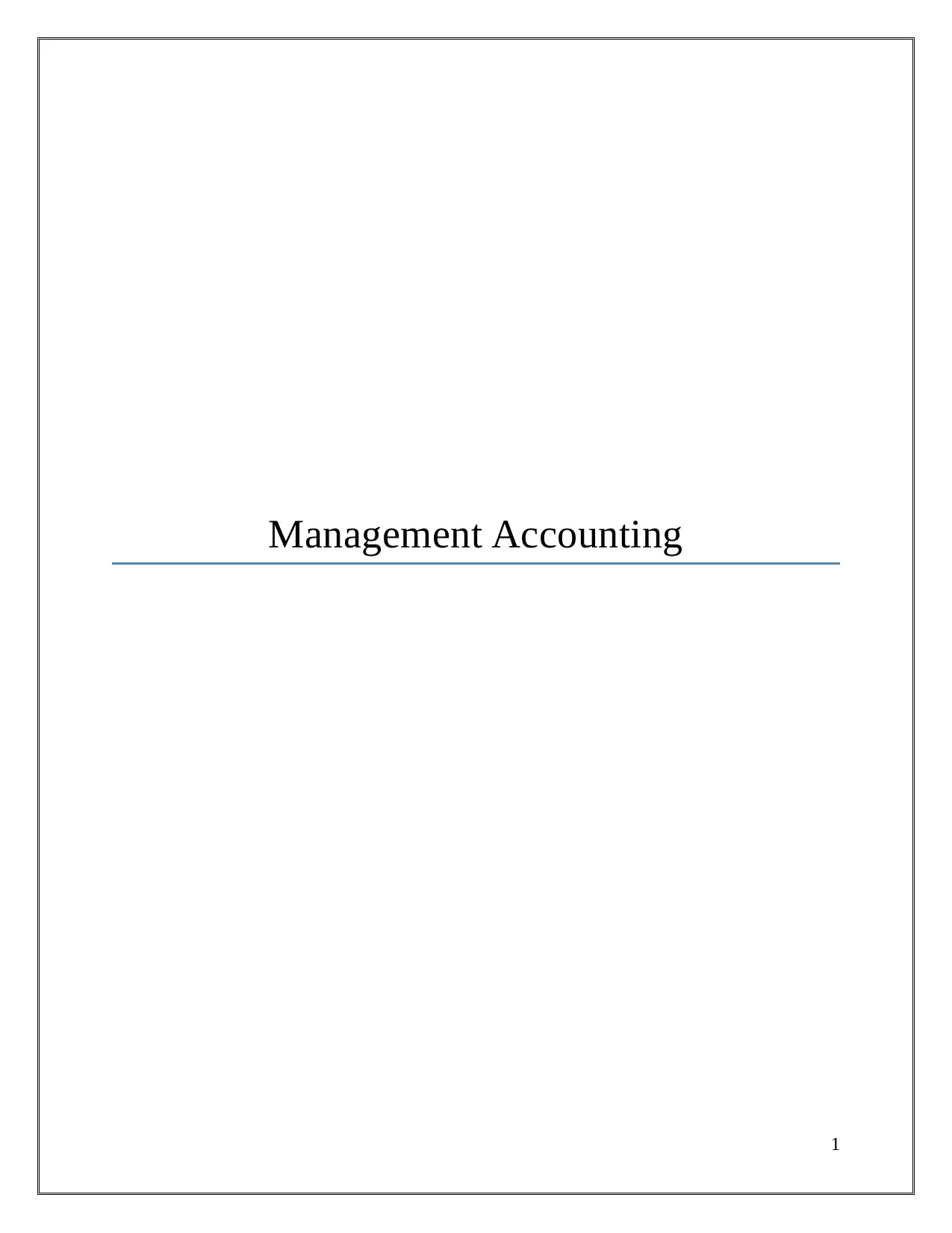
Management Accounting
1
1
Secure Best Marks with AI Grader
Need help grading? Try our AI Grader for instant feedback on your assignments.
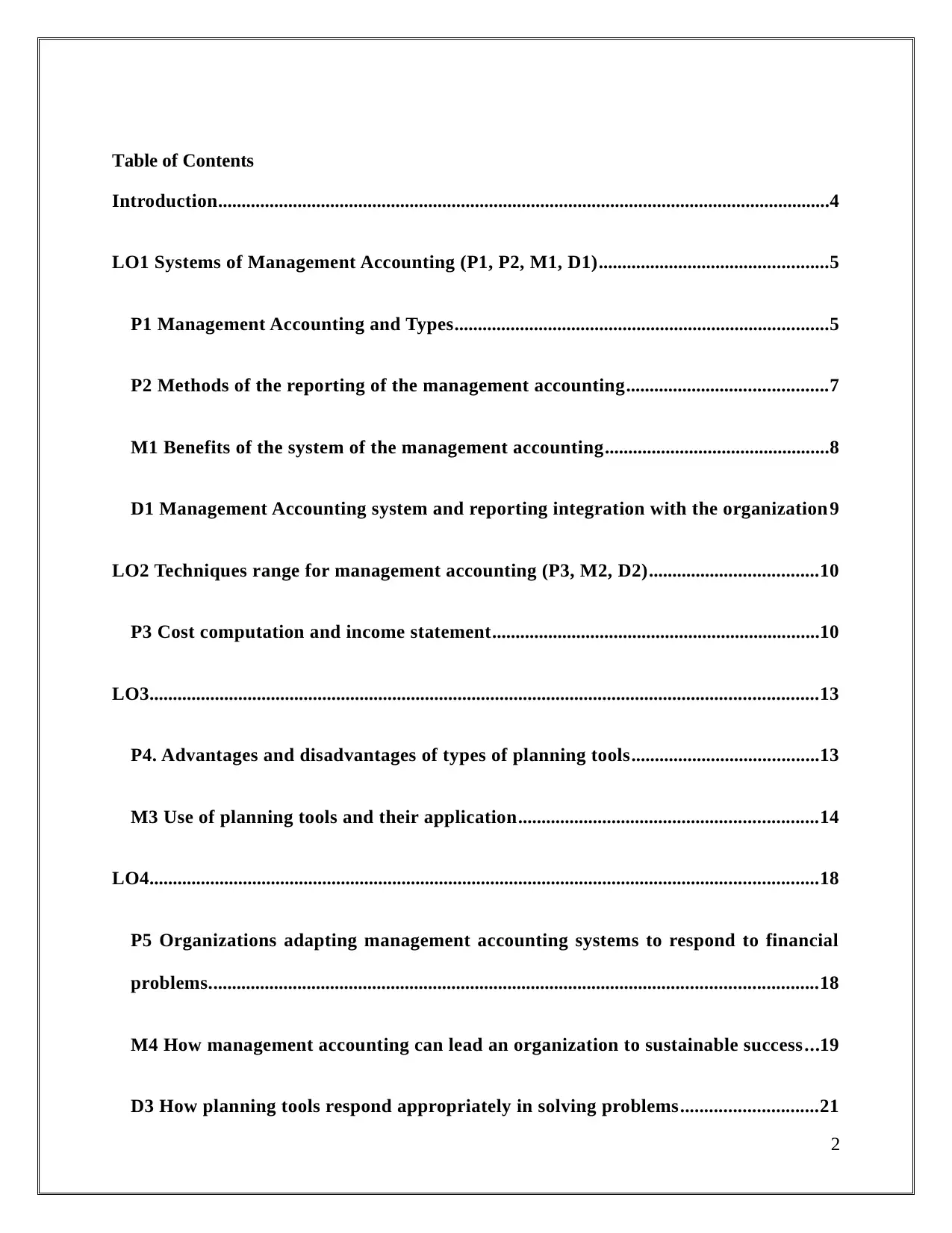
Table of Contents
Introduction...................................................................................................................................4
LO1 Systems of Management Accounting (P1, P2, M1, D1).................................................5
P1 Management Accounting and Types................................................................................5
P2 Methods of the reporting of the management accounting...........................................7
M1 Benefits of the system of the management accounting................................................8
D1 Management Accounting system and reporting integration with the organization 9
LO2 Techniques range for management accounting (P3, M2, D2)....................................10
P3 Cost computation and income statement......................................................................10
LO3...............................................................................................................................................13
P4. Advantages and disadvantages of types of planning tools........................................13
M3 Use of planning tools and their application................................................................14
LO4...............................................................................................................................................18
P5 Organizations adapting management accounting systems to respond to financial
problems..................................................................................................................................18
M4 How management accounting can lead an organization to sustainable success...19
D3 How planning tools respond appropriately in solving problems.............................21
2
Introduction...................................................................................................................................4
LO1 Systems of Management Accounting (P1, P2, M1, D1).................................................5
P1 Management Accounting and Types................................................................................5
P2 Methods of the reporting of the management accounting...........................................7
M1 Benefits of the system of the management accounting................................................8
D1 Management Accounting system and reporting integration with the organization 9
LO2 Techniques range for management accounting (P3, M2, D2)....................................10
P3 Cost computation and income statement......................................................................10
LO3...............................................................................................................................................13
P4. Advantages and disadvantages of types of planning tools........................................13
M3 Use of planning tools and their application................................................................14
LO4...............................................................................................................................................18
P5 Organizations adapting management accounting systems to respond to financial
problems..................................................................................................................................18
M4 How management accounting can lead an organization to sustainable success...19
D3 How planning tools respond appropriately in solving problems.............................21
2
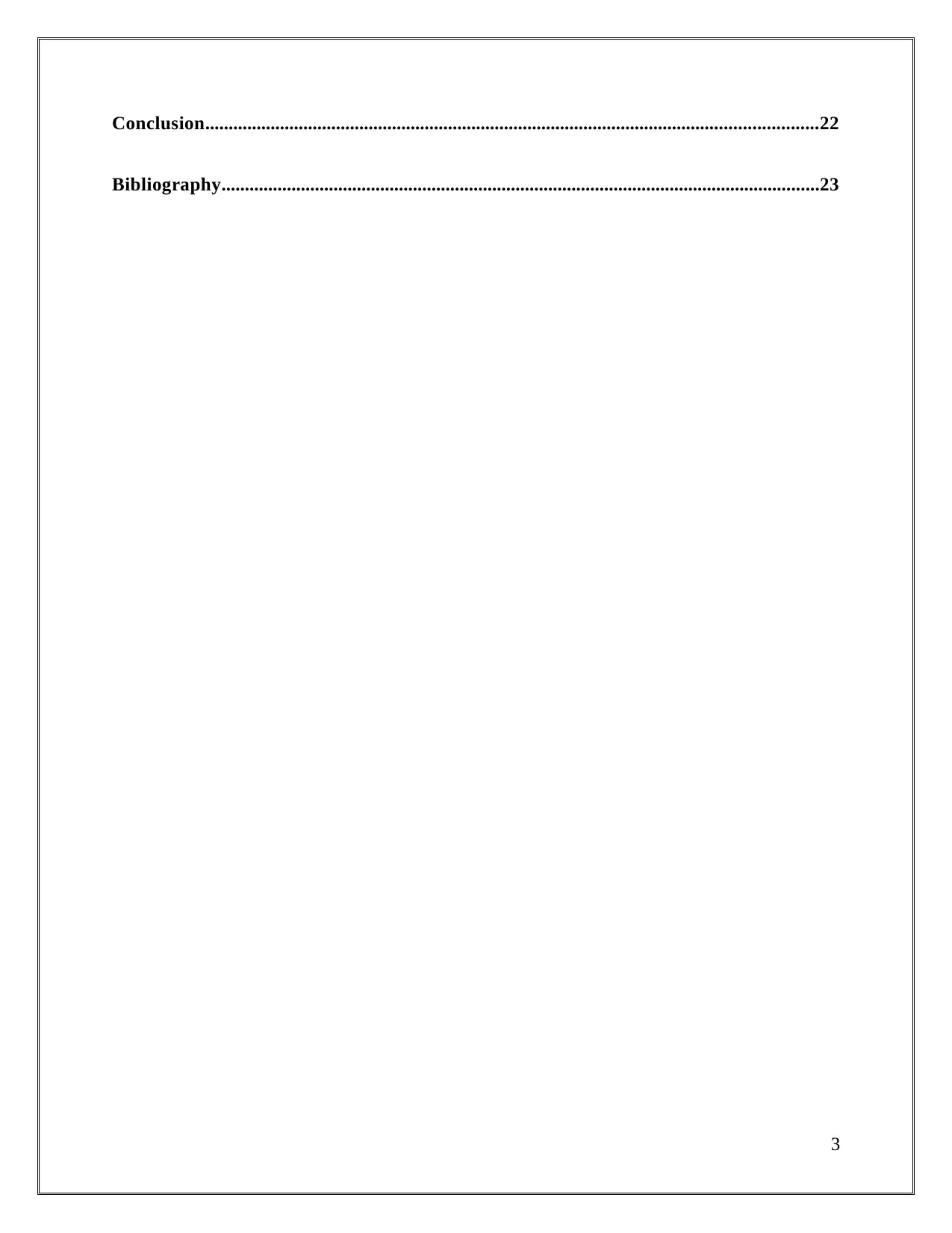
Conclusion...................................................................................................................................22
Bibliography................................................................................................................................23
3
Bibliography................................................................................................................................23
3
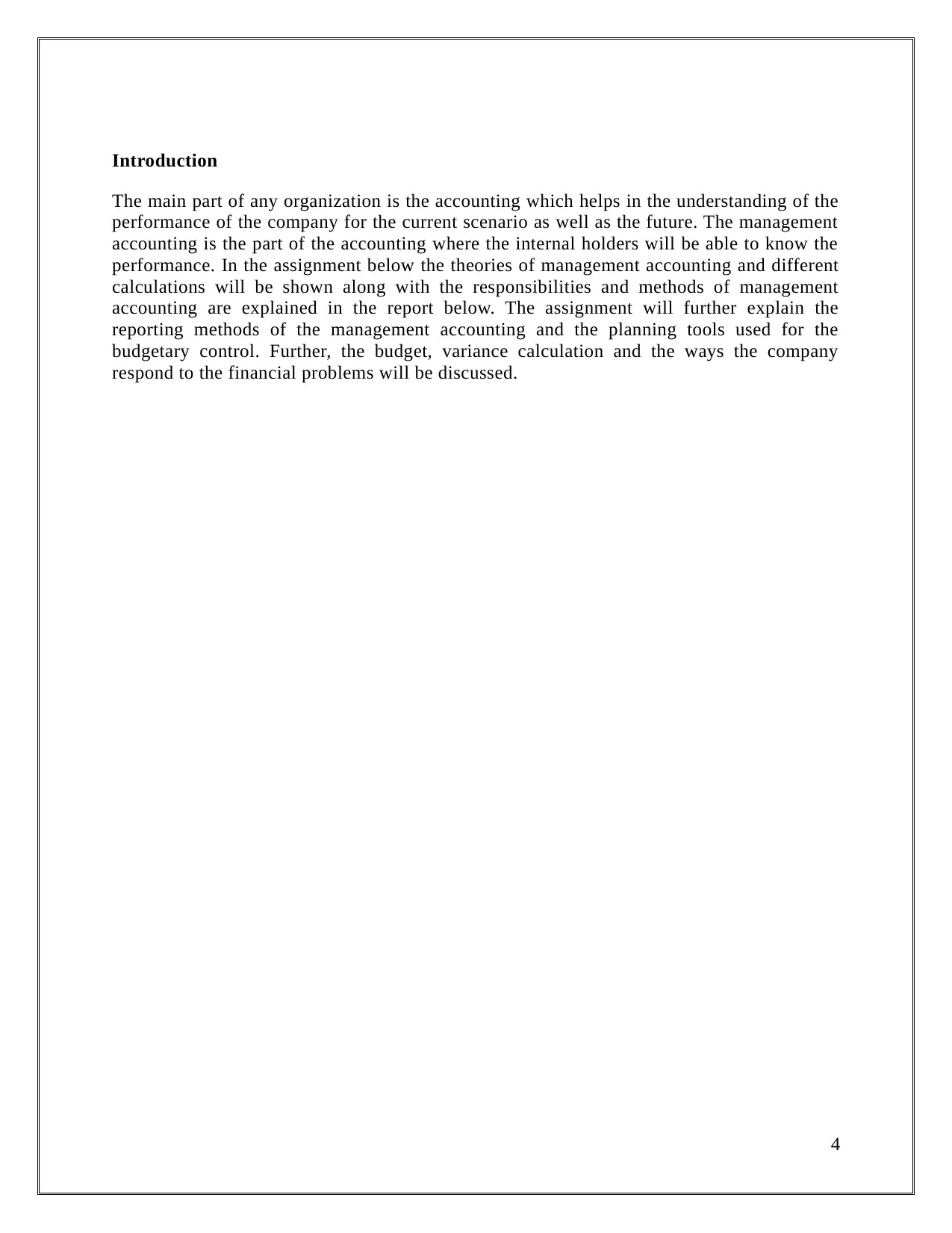
Introduction
The main part of any organization is the accounting which helps in the understanding of the
performance of the company for the current scenario as well as the future. The management
accounting is the part of the accounting where the internal holders will be able to know the
performance. In the assignment below the theories of management accounting and different
calculations will be shown along with the responsibilities and methods of management
accounting are explained in the report below. The assignment will further explain the
reporting methods of the management accounting and the planning tools used for the
budgetary control. Further, the budget, variance calculation and the ways the company
respond to the financial problems will be discussed.
4
The main part of any organization is the accounting which helps in the understanding of the
performance of the company for the current scenario as well as the future. The management
accounting is the part of the accounting where the internal holders will be able to know the
performance. In the assignment below the theories of management accounting and different
calculations will be shown along with the responsibilities and methods of management
accounting are explained in the report below. The assignment will further explain the
reporting methods of the management accounting and the planning tools used for the
budgetary control. Further, the budget, variance calculation and the ways the company
respond to the financial problems will be discussed.
4
Secure Best Marks with AI Grader
Need help grading? Try our AI Grader for instant feedback on your assignments.
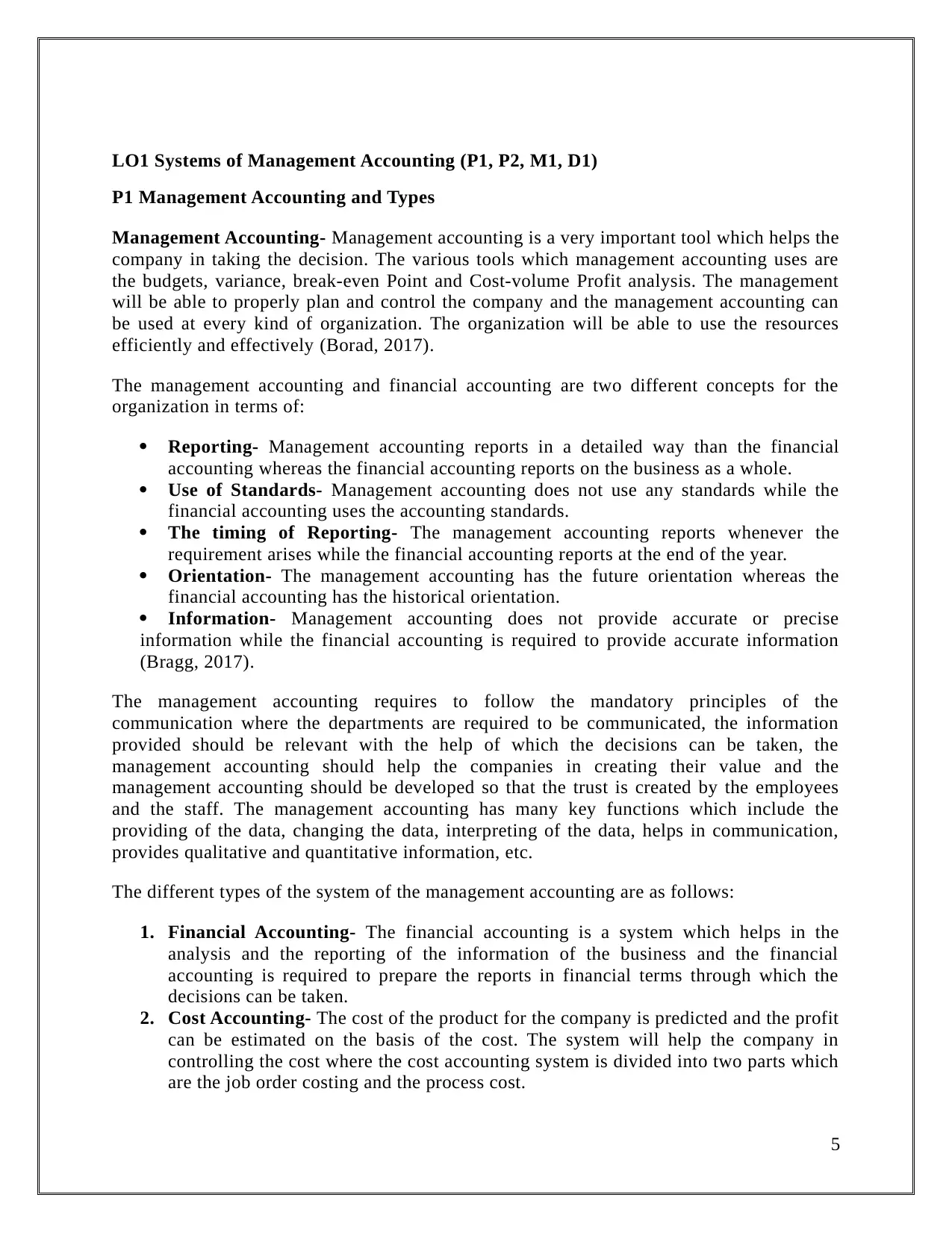
LO1 Systems of Management Accounting (P1, P2, M1, D1)
P1 Management Accounting and Types
Management Accounting- Management accounting is a very important tool which helps the
company in taking the decision. The various tools which management accounting uses are
the budgets, variance, break-even Point and Cost-volume Profit analysis. The management
will be able to properly plan and control the company and the management accounting can
be used at every kind of organization. The organization will be able to use the resources
efficiently and effectively (Borad, 2017).
The management accounting and financial accounting are two different concepts for the
organization in terms of:
Reporting- Management accounting reports in a detailed way than the financial
accounting whereas the financial accounting reports on the business as a whole.
Use of Standards- Management accounting does not use any standards while the
financial accounting uses the accounting standards.
The timing of Reporting- The management accounting reports whenever the
requirement arises while the financial accounting reports at the end of the year.
Orientation- The management accounting has the future orientation whereas the
financial accounting has the historical orientation.
Information- Management accounting does not provide accurate or precise
information while the financial accounting is required to provide accurate information
(Bragg, 2017).
The management accounting requires to follow the mandatory principles of the
communication where the departments are required to be communicated, the information
provided should be relevant with the help of which the decisions can be taken, the
management accounting should help the companies in creating their value and the
management accounting should be developed so that the trust is created by the employees
and the staff. The management accounting has many key functions which include the
providing of the data, changing the data, interpreting of the data, helps in communication,
provides qualitative and quantitative information, etc.
The different types of the system of the management accounting are as follows:
1. Financial Accounting- The financial accounting is a system which helps in the
analysis and the reporting of the information of the business and the financial
accounting is required to prepare the reports in financial terms through which the
decisions can be taken.
2. Cost Accounting- The cost of the product for the company is predicted and the profit
can be estimated on the basis of the cost. The system will help the company in
controlling the cost where the cost accounting system is divided into two parts which
are the job order costing and the process cost.
5
P1 Management Accounting and Types
Management Accounting- Management accounting is a very important tool which helps the
company in taking the decision. The various tools which management accounting uses are
the budgets, variance, break-even Point and Cost-volume Profit analysis. The management
will be able to properly plan and control the company and the management accounting can
be used at every kind of organization. The organization will be able to use the resources
efficiently and effectively (Borad, 2017).
The management accounting and financial accounting are two different concepts for the
organization in terms of:
Reporting- Management accounting reports in a detailed way than the financial
accounting whereas the financial accounting reports on the business as a whole.
Use of Standards- Management accounting does not use any standards while the
financial accounting uses the accounting standards.
The timing of Reporting- The management accounting reports whenever the
requirement arises while the financial accounting reports at the end of the year.
Orientation- The management accounting has the future orientation whereas the
financial accounting has the historical orientation.
Information- Management accounting does not provide accurate or precise
information while the financial accounting is required to provide accurate information
(Bragg, 2017).
The management accounting requires to follow the mandatory principles of the
communication where the departments are required to be communicated, the information
provided should be relevant with the help of which the decisions can be taken, the
management accounting should help the companies in creating their value and the
management accounting should be developed so that the trust is created by the employees
and the staff. The management accounting has many key functions which include the
providing of the data, changing the data, interpreting of the data, helps in communication,
provides qualitative and quantitative information, etc.
The different types of the system of the management accounting are as follows:
1. Financial Accounting- The financial accounting is a system which helps in the
analysis and the reporting of the information of the business and the financial
accounting is required to prepare the reports in financial terms through which the
decisions can be taken.
2. Cost Accounting- The cost of the product for the company is predicted and the profit
can be estimated on the basis of the cost. The system will help the company in
controlling the cost where the cost accounting system is divided into two parts which
are the job order costing and the process cost.
5
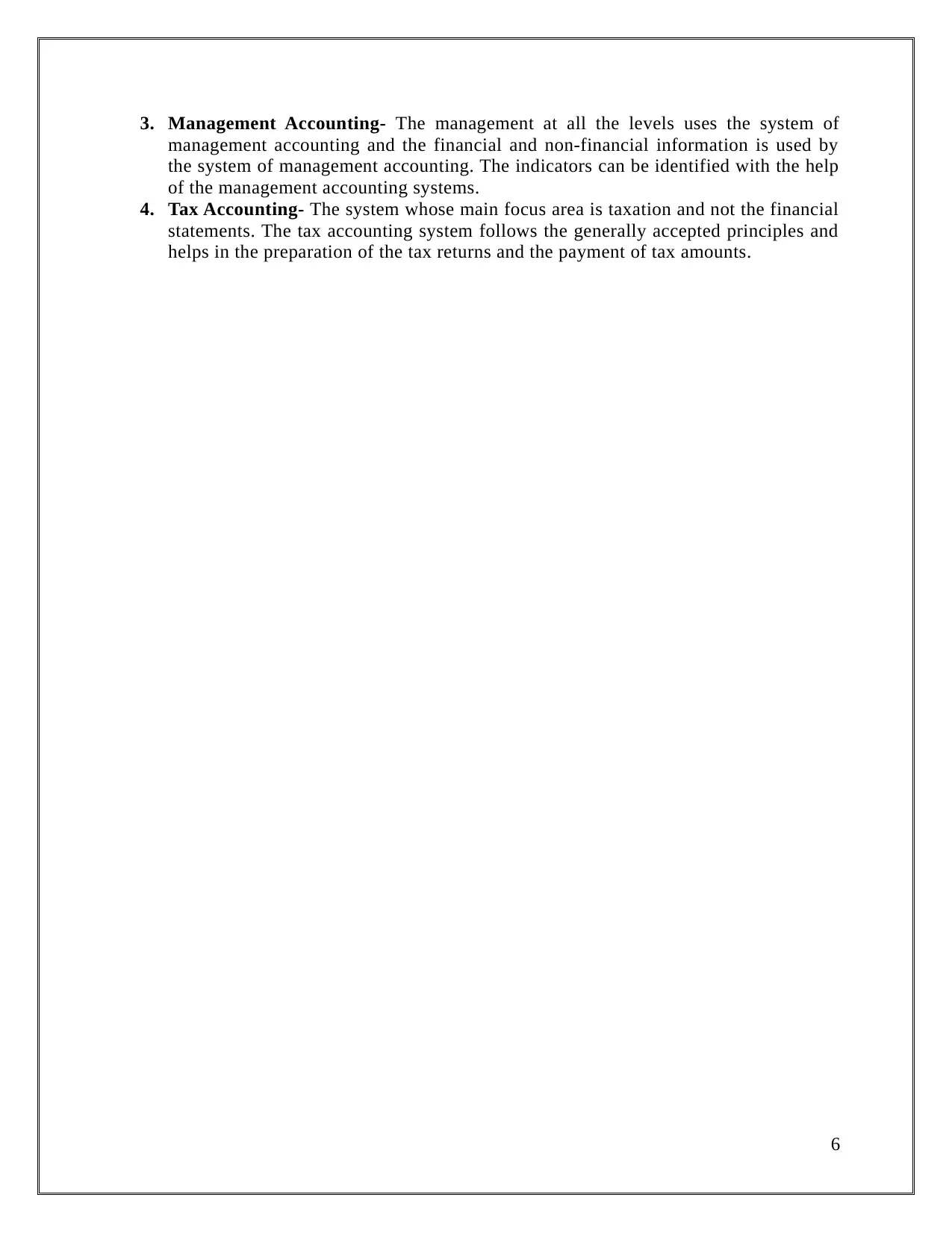
3. Management Accounting- The management at all the levels uses the system of
management accounting and the financial and non-financial information is used by
the system of management accounting. The indicators can be identified with the help
of the management accounting systems.
4. Tax Accounting- The system whose main focus area is taxation and not the financial
statements. The tax accounting system follows the generally accepted principles and
helps in the preparation of the tax returns and the payment of tax amounts.
6
management accounting and the financial and non-financial information is used by
the system of management accounting. The indicators can be identified with the help
of the management accounting systems.
4. Tax Accounting- The system whose main focus area is taxation and not the financial
statements. The tax accounting system follows the generally accepted principles and
helps in the preparation of the tax returns and the payment of tax amounts.
6
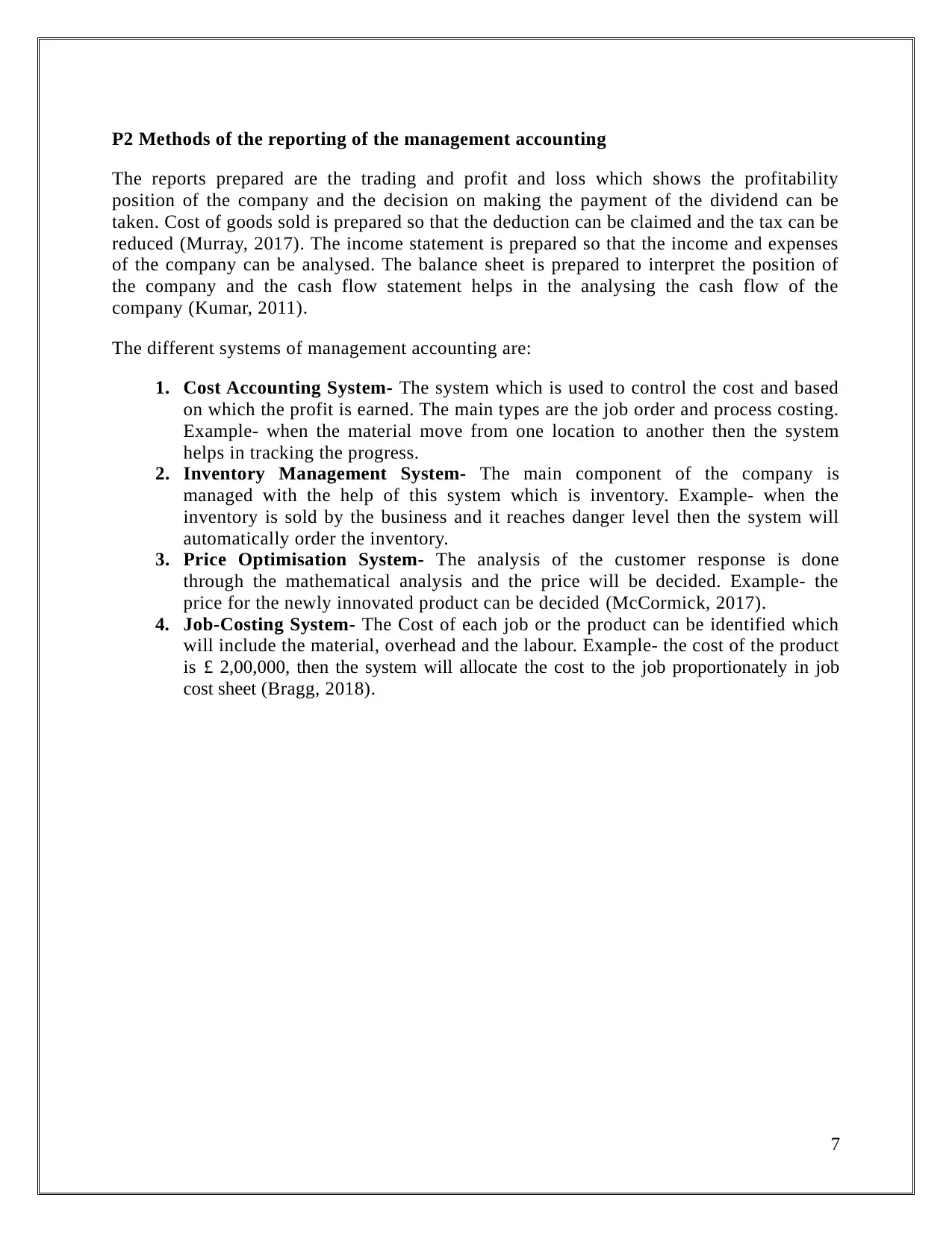
P2 Methods of the reporting of the management accounting
The reports prepared are the trading and profit and loss which shows the profitability
position of the company and the decision on making the payment of the dividend can be
taken. Cost of goods sold is prepared so that the deduction can be claimed and the tax can be
reduced (Murray, 2017). The income statement is prepared so that the income and expenses
of the company can be analysed. The balance sheet is prepared to interpret the position of
the company and the cash flow statement helps in the analysing the cash flow of the
company (Kumar, 2011).
The different systems of management accounting are:
1. Cost Accounting System- The system which is used to control the cost and based
on which the profit is earned. The main types are the job order and process costing.
Example- when the material move from one location to another then the system
helps in tracking the progress.
2. Inventory Management System- The main component of the company is
managed with the help of this system which is inventory. Example- when the
inventory is sold by the business and it reaches danger level then the system will
automatically order the inventory.
3. Price Optimisation System- The analysis of the customer response is done
through the mathematical analysis and the price will be decided. Example- the
price for the newly innovated product can be decided (McCormick, 2017).
4. Job-Costing System- The Cost of each job or the product can be identified which
will include the material, overhead and the labour. Example- the cost of the product
is £ 2,00,000, then the system will allocate the cost to the job proportionately in job
cost sheet (Bragg, 2018).
7
The reports prepared are the trading and profit and loss which shows the profitability
position of the company and the decision on making the payment of the dividend can be
taken. Cost of goods sold is prepared so that the deduction can be claimed and the tax can be
reduced (Murray, 2017). The income statement is prepared so that the income and expenses
of the company can be analysed. The balance sheet is prepared to interpret the position of
the company and the cash flow statement helps in the analysing the cash flow of the
company (Kumar, 2011).
The different systems of management accounting are:
1. Cost Accounting System- The system which is used to control the cost and based
on which the profit is earned. The main types are the job order and process costing.
Example- when the material move from one location to another then the system
helps in tracking the progress.
2. Inventory Management System- The main component of the company is
managed with the help of this system which is inventory. Example- when the
inventory is sold by the business and it reaches danger level then the system will
automatically order the inventory.
3. Price Optimisation System- The analysis of the customer response is done
through the mathematical analysis and the price will be decided. Example- the
price for the newly innovated product can be decided (McCormick, 2017).
4. Job-Costing System- The Cost of each job or the product can be identified which
will include the material, overhead and the labour. Example- the cost of the product
is £ 2,00,000, then the system will allocate the cost to the job proportionately in job
cost sheet (Bragg, 2018).
7
Paraphrase This Document
Need a fresh take? Get an instant paraphrase of this document with our AI Paraphraser
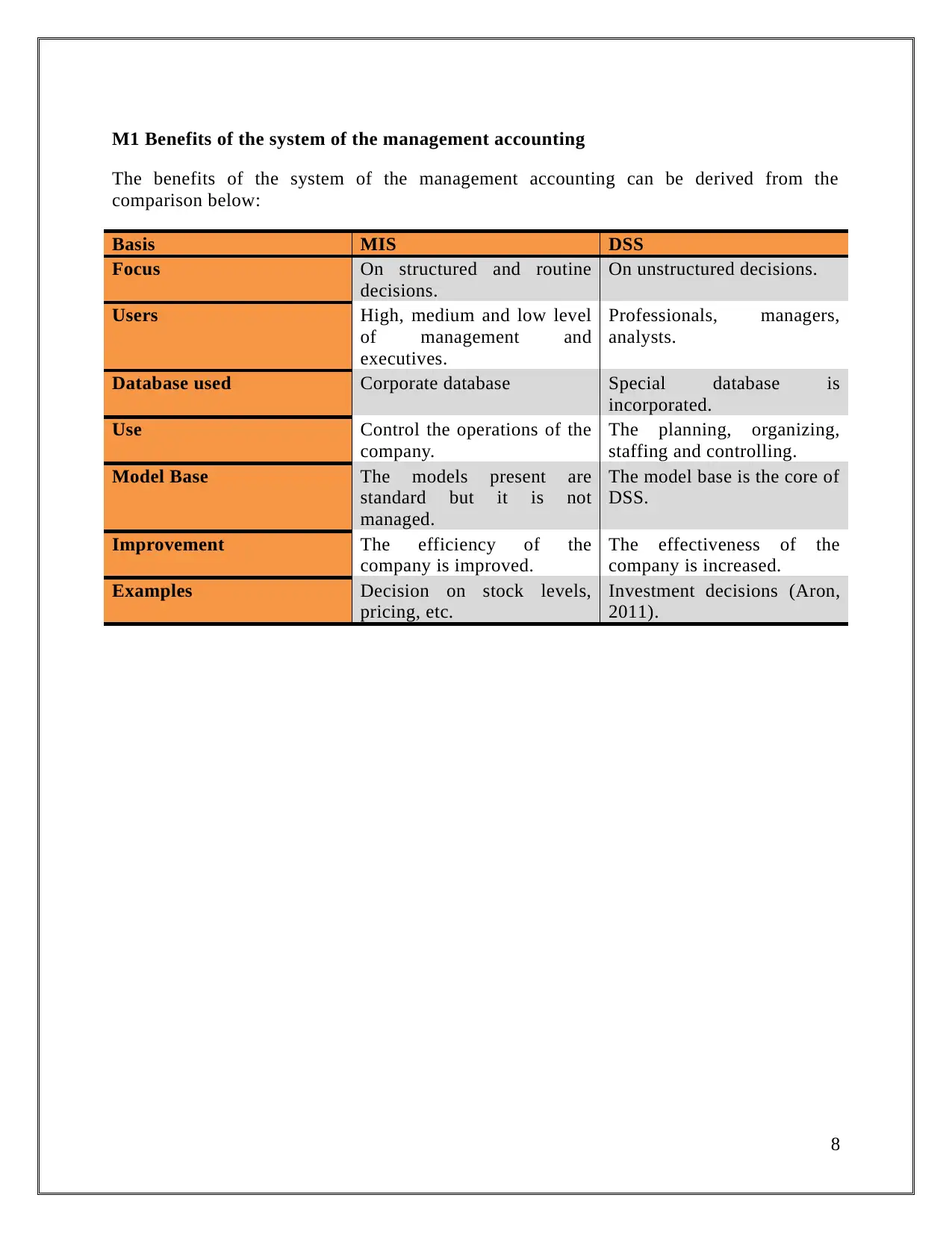
M1 Benefits of the system of the management accounting
The benefits of the system of the management accounting can be derived from the
comparison below:
Basis MIS DSS
Focus On structured and routine
decisions.
On unstructured decisions.
Users High, medium and low level
of management and
executives.
Professionals, managers,
analysts.
Database used Corporate database Special database is
incorporated.
Use Control the operations of the
company.
The planning, organizing,
staffing and controlling.
Model Base The models present are
standard but it is not
managed.
The model base is the core of
DSS.
Improvement The efficiency of the
company is improved.
The effectiveness of the
company is increased.
Examples Decision on stock levels,
pricing, etc.
Investment decisions (Aron,
2011).
8
The benefits of the system of the management accounting can be derived from the
comparison below:
Basis MIS DSS
Focus On structured and routine
decisions.
On unstructured decisions.
Users High, medium and low level
of management and
executives.
Professionals, managers,
analysts.
Database used Corporate database Special database is
incorporated.
Use Control the operations of the
company.
The planning, organizing,
staffing and controlling.
Model Base The models present are
standard but it is not
managed.
The model base is the core of
DSS.
Improvement The efficiency of the
company is improved.
The effectiveness of the
company is increased.
Examples Decision on stock levels,
pricing, etc.
Investment decisions (Aron,
2011).
8
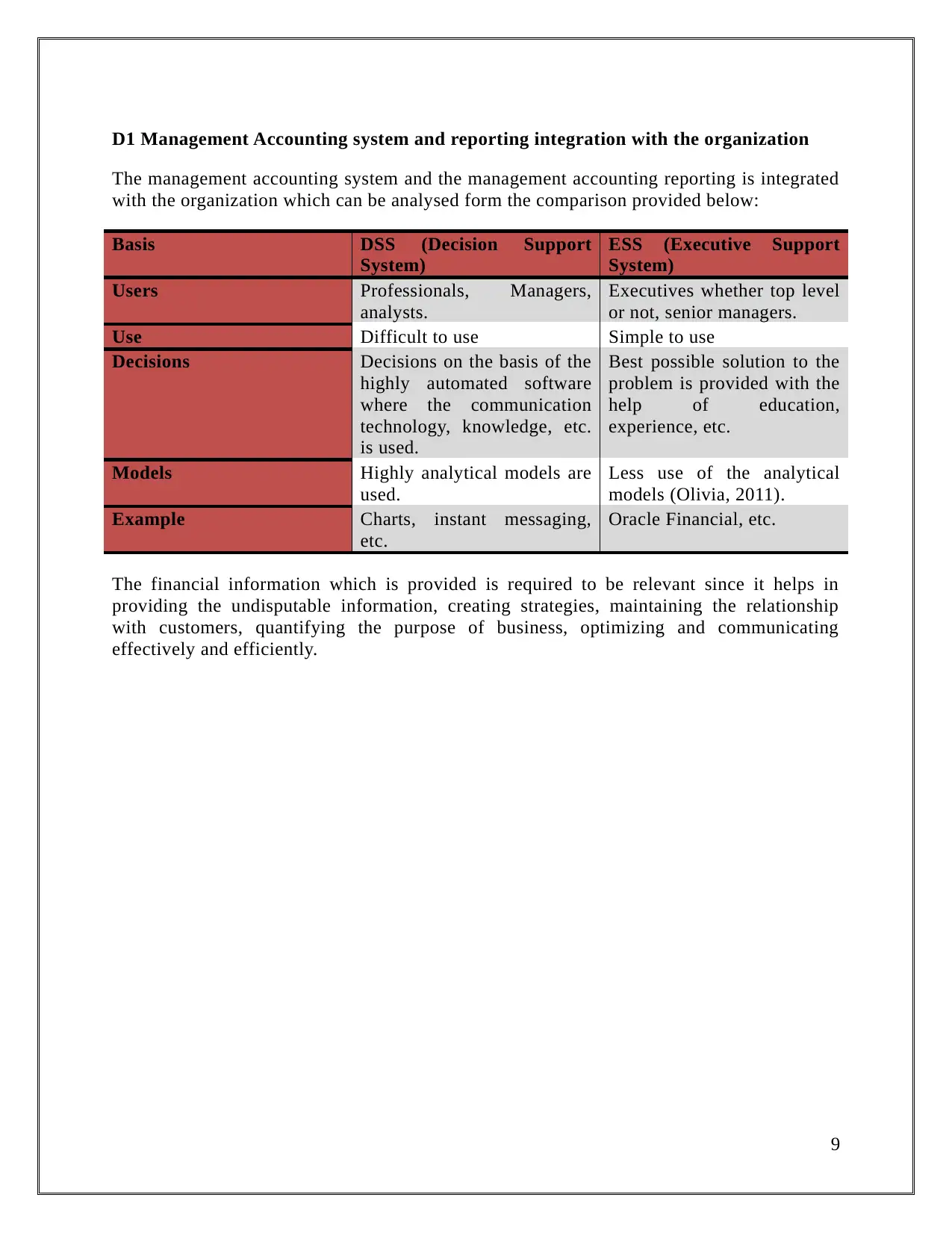
D1 Management Accounting system and reporting integration with the organization
The management accounting system and the management accounting reporting is integrated
with the organization which can be analysed form the comparison provided below:
Basis DSS (Decision Support
System)
ESS (Executive Support
System)
Users Professionals, Managers,
analysts.
Executives whether top level
or not, senior managers.
Use Difficult to use Simple to use
Decisions Decisions on the basis of the
highly automated software
where the communication
technology, knowledge, etc.
is used.
Best possible solution to the
problem is provided with the
help of education,
experience, etc.
Models Highly analytical models are
used.
Less use of the analytical
models (Olivia, 2011).
Example Charts, instant messaging,
etc.
Oracle Financial, etc.
The financial information which is provided is required to be relevant since it helps in
providing the undisputable information, creating strategies, maintaining the relationship
with customers, quantifying the purpose of business, optimizing and communicating
effectively and efficiently.
9
The management accounting system and the management accounting reporting is integrated
with the organization which can be analysed form the comparison provided below:
Basis DSS (Decision Support
System)
ESS (Executive Support
System)
Users Professionals, Managers,
analysts.
Executives whether top level
or not, senior managers.
Use Difficult to use Simple to use
Decisions Decisions on the basis of the
highly automated software
where the communication
technology, knowledge, etc.
is used.
Best possible solution to the
problem is provided with the
help of education,
experience, etc.
Models Highly analytical models are
used.
Less use of the analytical
models (Olivia, 2011).
Example Charts, instant messaging,
etc.
Oracle Financial, etc.
The financial information which is provided is required to be relevant since it helps in
providing the undisputable information, creating strategies, maintaining the relationship
with customers, quantifying the purpose of business, optimizing and communicating
effectively and efficiently.
9
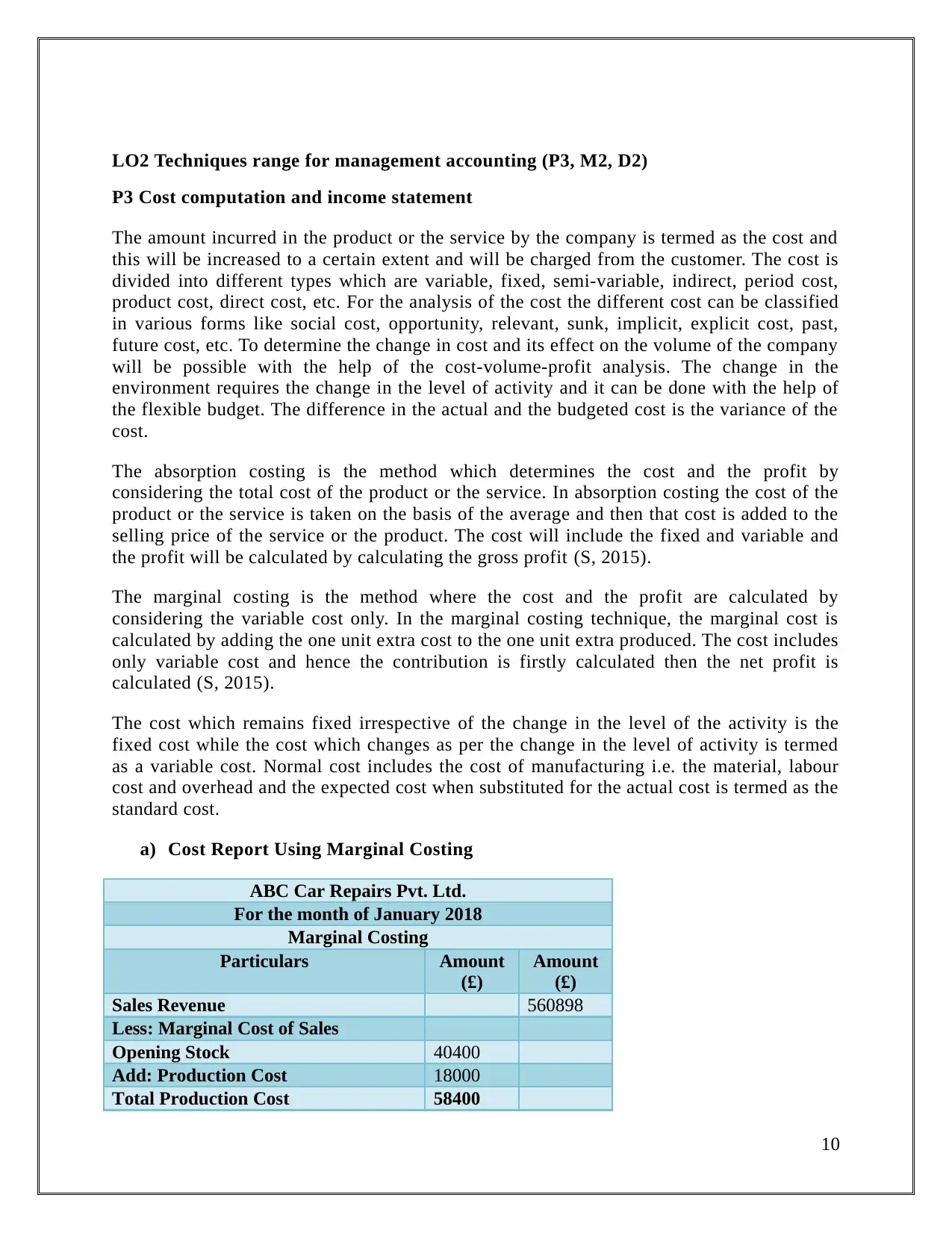
LO2 Techniques range for management accounting (P3, M2, D2)
P3 Cost computation and income statement
The amount incurred in the product or the service by the company is termed as the cost and
this will be increased to a certain extent and will be charged from the customer. The cost is
divided into different types which are variable, fixed, semi-variable, indirect, period cost,
product cost, direct cost, etc. For the analysis of the cost the different cost can be classified
in various forms like social cost, opportunity, relevant, sunk, implicit, explicit cost, past,
future cost, etc. To determine the change in cost and its effect on the volume of the company
will be possible with the help of the cost-volume-profit analysis. The change in the
environment requires the change in the level of activity and it can be done with the help of
the flexible budget. The difference in the actual and the budgeted cost is the variance of the
cost.
The absorption costing is the method which determines the cost and the profit by
considering the total cost of the product or the service. In absorption costing the cost of the
product or the service is taken on the basis of the average and then that cost is added to the
selling price of the service or the product. The cost will include the fixed and variable and
the profit will be calculated by calculating the gross profit (S, 2015).
The marginal costing is the method where the cost and the profit are calculated by
considering the variable cost only. In the marginal costing technique, the marginal cost is
calculated by adding the one unit extra cost to the one unit extra produced. The cost includes
only variable cost and hence the contribution is firstly calculated then the net profit is
calculated (S, 2015).
The cost which remains fixed irrespective of the change in the level of the activity is the
fixed cost while the cost which changes as per the change in the level of activity is termed
as a variable cost. Normal cost includes the cost of manufacturing i.e. the material, labour
cost and overhead and the expected cost when substituted for the actual cost is termed as the
standard cost.
a) Cost Report Using Marginal Costing
ABC Car Repairs Pvt. Ltd.
For the month of January 2018
Marginal Costing
Particulars Amount
(£)
Amount
(£)
Sales Revenue 560898
Less: Marginal Cost of Sales
Opening Stock 40400
Add: Production Cost 18000
Total Production Cost 58400
10
P3 Cost computation and income statement
The amount incurred in the product or the service by the company is termed as the cost and
this will be increased to a certain extent and will be charged from the customer. The cost is
divided into different types which are variable, fixed, semi-variable, indirect, period cost,
product cost, direct cost, etc. For the analysis of the cost the different cost can be classified
in various forms like social cost, opportunity, relevant, sunk, implicit, explicit cost, past,
future cost, etc. To determine the change in cost and its effect on the volume of the company
will be possible with the help of the cost-volume-profit analysis. The change in the
environment requires the change in the level of activity and it can be done with the help of
the flexible budget. The difference in the actual and the budgeted cost is the variance of the
cost.
The absorption costing is the method which determines the cost and the profit by
considering the total cost of the product or the service. In absorption costing the cost of the
product or the service is taken on the basis of the average and then that cost is added to the
selling price of the service or the product. The cost will include the fixed and variable and
the profit will be calculated by calculating the gross profit (S, 2015).
The marginal costing is the method where the cost and the profit are calculated by
considering the variable cost only. In the marginal costing technique, the marginal cost is
calculated by adding the one unit extra cost to the one unit extra produced. The cost includes
only variable cost and hence the contribution is firstly calculated then the net profit is
calculated (S, 2015).
The cost which remains fixed irrespective of the change in the level of the activity is the
fixed cost while the cost which changes as per the change in the level of activity is termed
as a variable cost. Normal cost includes the cost of manufacturing i.e. the material, labour
cost and overhead and the expected cost when substituted for the actual cost is termed as the
standard cost.
a) Cost Report Using Marginal Costing
ABC Car Repairs Pvt. Ltd.
For the month of January 2018
Marginal Costing
Particulars Amount
(£)
Amount
(£)
Sales Revenue 560898
Less: Marginal Cost of Sales
Opening Stock 40400
Add: Production Cost 18000
Total Production Cost 58400
10
Secure Best Marks with AI Grader
Need help grading? Try our AI Grader for instant feedback on your assignments.
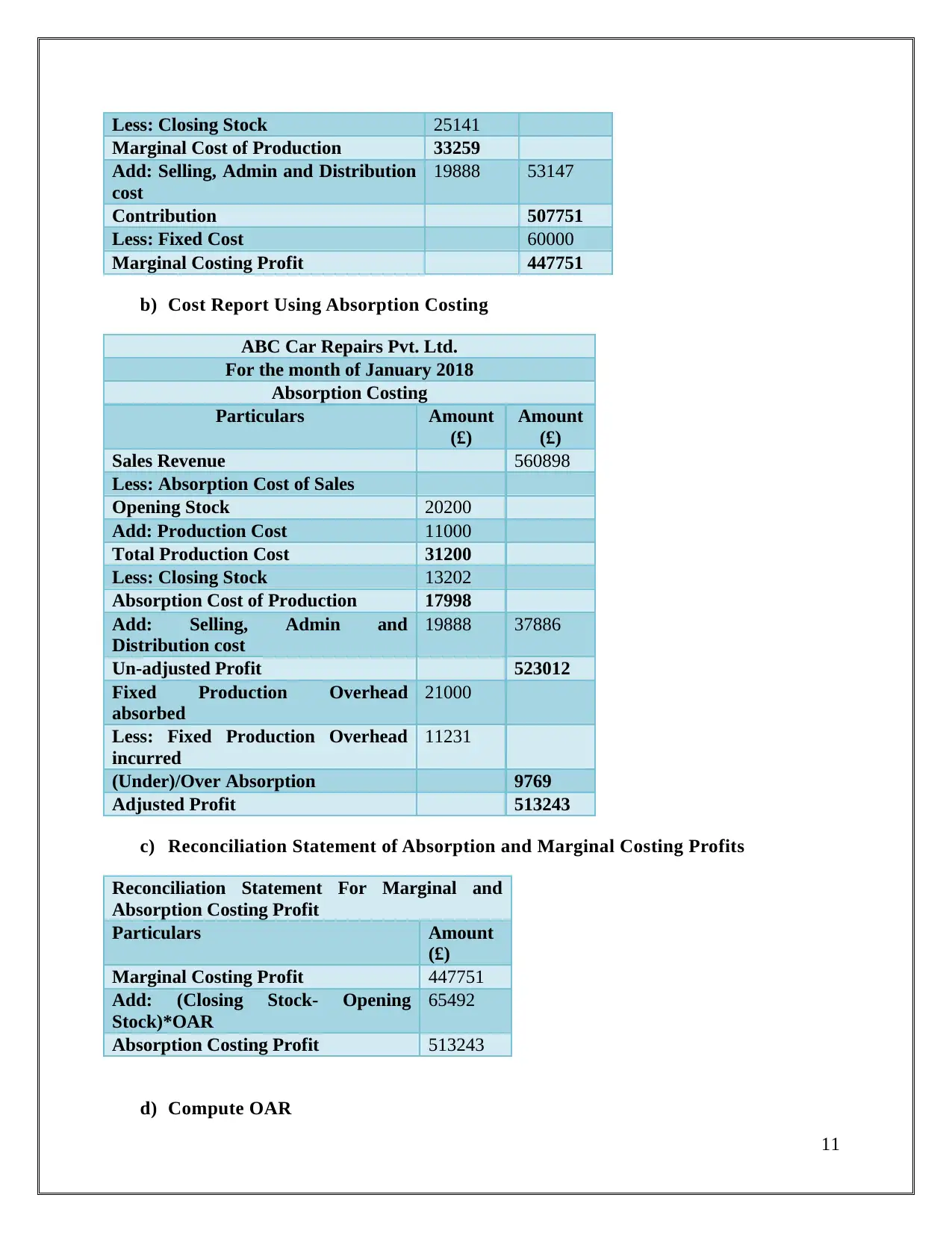
Less: Closing Stock 25141
Marginal Cost of Production 33259
Add: Selling, Admin and Distribution
cost
19888 53147
Contribution 507751
Less: Fixed Cost 60000
Marginal Costing Profit 447751
b) Cost Report Using Absorption Costing
ABC Car Repairs Pvt. Ltd.
For the month of January 2018
Absorption Costing
Particulars Amount
(£)
Amount
(£)
Sales Revenue 560898
Less: Absorption Cost of Sales
Opening Stock 20200
Add: Production Cost 11000
Total Production Cost 31200
Less: Closing Stock 13202
Absorption Cost of Production 17998
Add: Selling, Admin and
Distribution cost
19888 37886
Un-adjusted Profit 523012
Fixed Production Overhead
absorbed
21000
Less: Fixed Production Overhead
incurred
11231
(Under)/Over Absorption 9769
Adjusted Profit 513243
c) Reconciliation Statement of Absorption and Marginal Costing Profits
Reconciliation Statement For Marginal and
Absorption Costing Profit
Particulars Amount
(£)
Marginal Costing Profit 447751
Add: (Closing Stock- Opening
Stock)*OAR
65492
Absorption Costing Profit 513243
d) Compute OAR
11
Marginal Cost of Production 33259
Add: Selling, Admin and Distribution
cost
19888 53147
Contribution 507751
Less: Fixed Cost 60000
Marginal Costing Profit 447751
b) Cost Report Using Absorption Costing
ABC Car Repairs Pvt. Ltd.
For the month of January 2018
Absorption Costing
Particulars Amount
(£)
Amount
(£)
Sales Revenue 560898
Less: Absorption Cost of Sales
Opening Stock 20200
Add: Production Cost 11000
Total Production Cost 31200
Less: Closing Stock 13202
Absorption Cost of Production 17998
Add: Selling, Admin and
Distribution cost
19888 37886
Un-adjusted Profit 523012
Fixed Production Overhead
absorbed
21000
Less: Fixed Production Overhead
incurred
11231
(Under)/Over Absorption 9769
Adjusted Profit 513243
c) Reconciliation Statement of Absorption and Marginal Costing Profits
Reconciliation Statement For Marginal and
Absorption Costing Profit
Particulars Amount
(£)
Marginal Costing Profit 447751
Add: (Closing Stock- Opening
Stock)*OAR
65492
Absorption Costing Profit 513243
d) Compute OAR
11
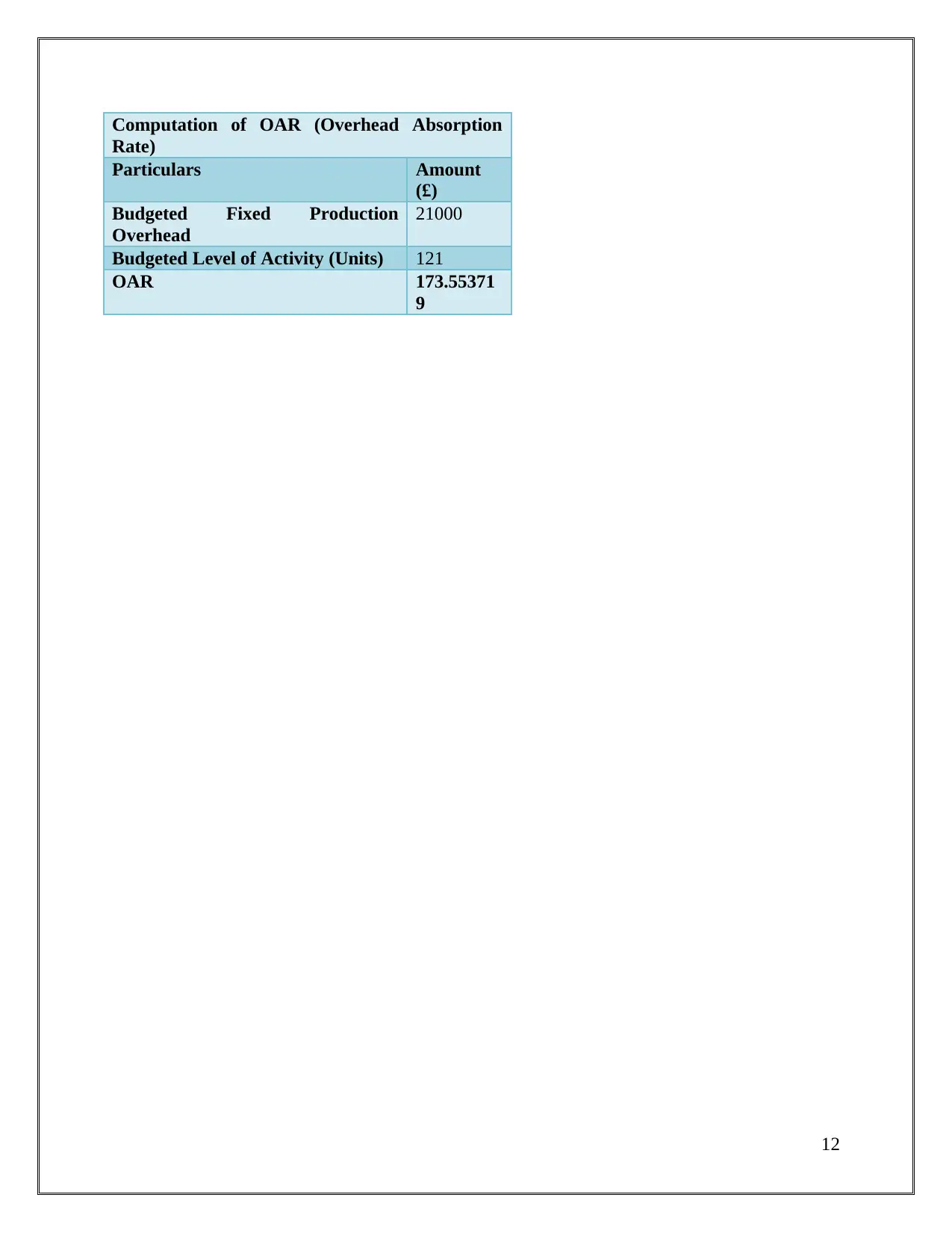
Computation of OAR (Overhead Absorption
Rate)
Particulars Amount
(£)
Budgeted Fixed Production
Overhead
21000
Budgeted Level of Activity (Units) 121
OAR 173.55371
9
12
Rate)
Particulars Amount
(£)
Budgeted Fixed Production
Overhead
21000
Budgeted Level of Activity (Units) 121
OAR 173.55371
9
12
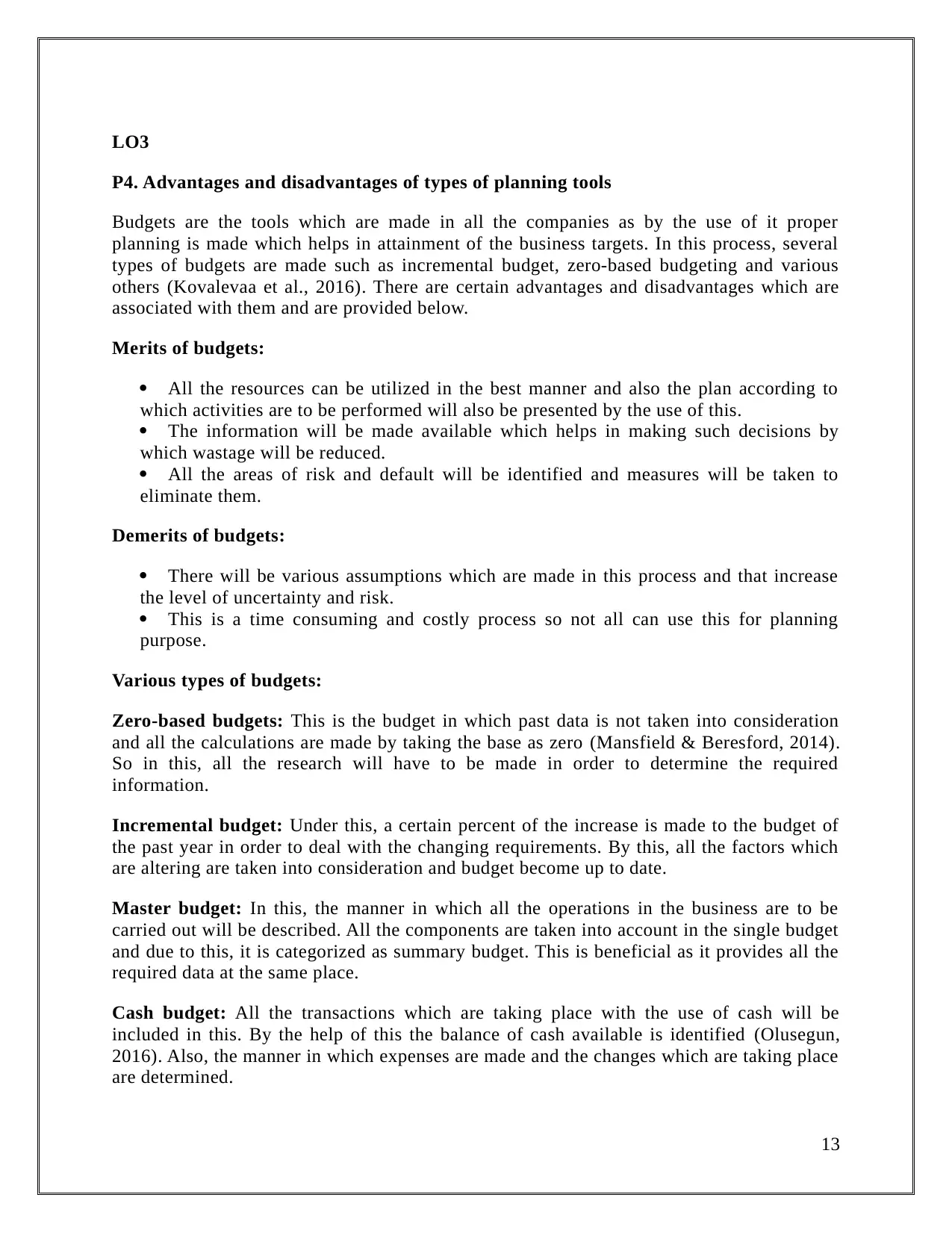
LO3
P4. Advantages and disadvantages of types of planning tools
Budgets are the tools which are made in all the companies as by the use of it proper
planning is made which helps in attainment of the business targets. In this process, several
types of budgets are made such as incremental budget, zero-based budgeting and various
others (Kovalevaa et al., 2016). There are certain advantages and disadvantages which are
associated with them and are provided below.
Merits of budgets:
All the resources can be utilized in the best manner and also the plan according to
which activities are to be performed will also be presented by the use of this.
The information will be made available which helps in making such decisions by
which wastage will be reduced.
All the areas of risk and default will be identified and measures will be taken to
eliminate them.
Demerits of budgets:
There will be various assumptions which are made in this process and that increase
the level of uncertainty and risk.
This is a time consuming and costly process so not all can use this for planning
purpose.
Various types of budgets:
Zero-based budgets: This is the budget in which past data is not taken into consideration
and all the calculations are made by taking the base as zero (Mansfield & Beresford, 2014).
So in this, all the research will have to be made in order to determine the required
information.
Incremental budget: Under this, a certain percent of the increase is made to the budget of
the past year in order to deal with the changing requirements. By this, all the factors which
are altering are taken into consideration and budget become up to date.
Master budget: In this, the manner in which all the operations in the business are to be
carried out will be described. All the components are taken into account in the single budget
and due to this, it is categorized as summary budget. This is beneficial as it provides all the
required data at the same place.
Cash budget: All the transactions which are taking place with the use of cash will be
included in this. By the help of this the balance of cash available is identified (Olusegun,
2016). Also, the manner in which expenses are made and the changes which are taking place
are determined.
13
P4. Advantages and disadvantages of types of planning tools
Budgets are the tools which are made in all the companies as by the use of it proper
planning is made which helps in attainment of the business targets. In this process, several
types of budgets are made such as incremental budget, zero-based budgeting and various
others (Kovalevaa et al., 2016). There are certain advantages and disadvantages which are
associated with them and are provided below.
Merits of budgets:
All the resources can be utilized in the best manner and also the plan according to
which activities are to be performed will also be presented by the use of this.
The information will be made available which helps in making such decisions by
which wastage will be reduced.
All the areas of risk and default will be identified and measures will be taken to
eliminate them.
Demerits of budgets:
There will be various assumptions which are made in this process and that increase
the level of uncertainty and risk.
This is a time consuming and costly process so not all can use this for planning
purpose.
Various types of budgets:
Zero-based budgets: This is the budget in which past data is not taken into consideration
and all the calculations are made by taking the base as zero (Mansfield & Beresford, 2014).
So in this, all the research will have to be made in order to determine the required
information.
Incremental budget: Under this, a certain percent of the increase is made to the budget of
the past year in order to deal with the changing requirements. By this, all the factors which
are altering are taken into consideration and budget become up to date.
Master budget: In this, the manner in which all the operations in the business are to be
carried out will be described. All the components are taken into account in the single budget
and due to this, it is categorized as summary budget. This is beneficial as it provides all the
required data at the same place.
Cash budget: All the transactions which are taking place with the use of cash will be
included in this. By the help of this the balance of cash available is identified (Olusegun,
2016). Also, the manner in which expenses are made and the changes which are taking place
are determined.
13
Paraphrase This Document
Need a fresh take? Get an instant paraphrase of this document with our AI Paraphraser
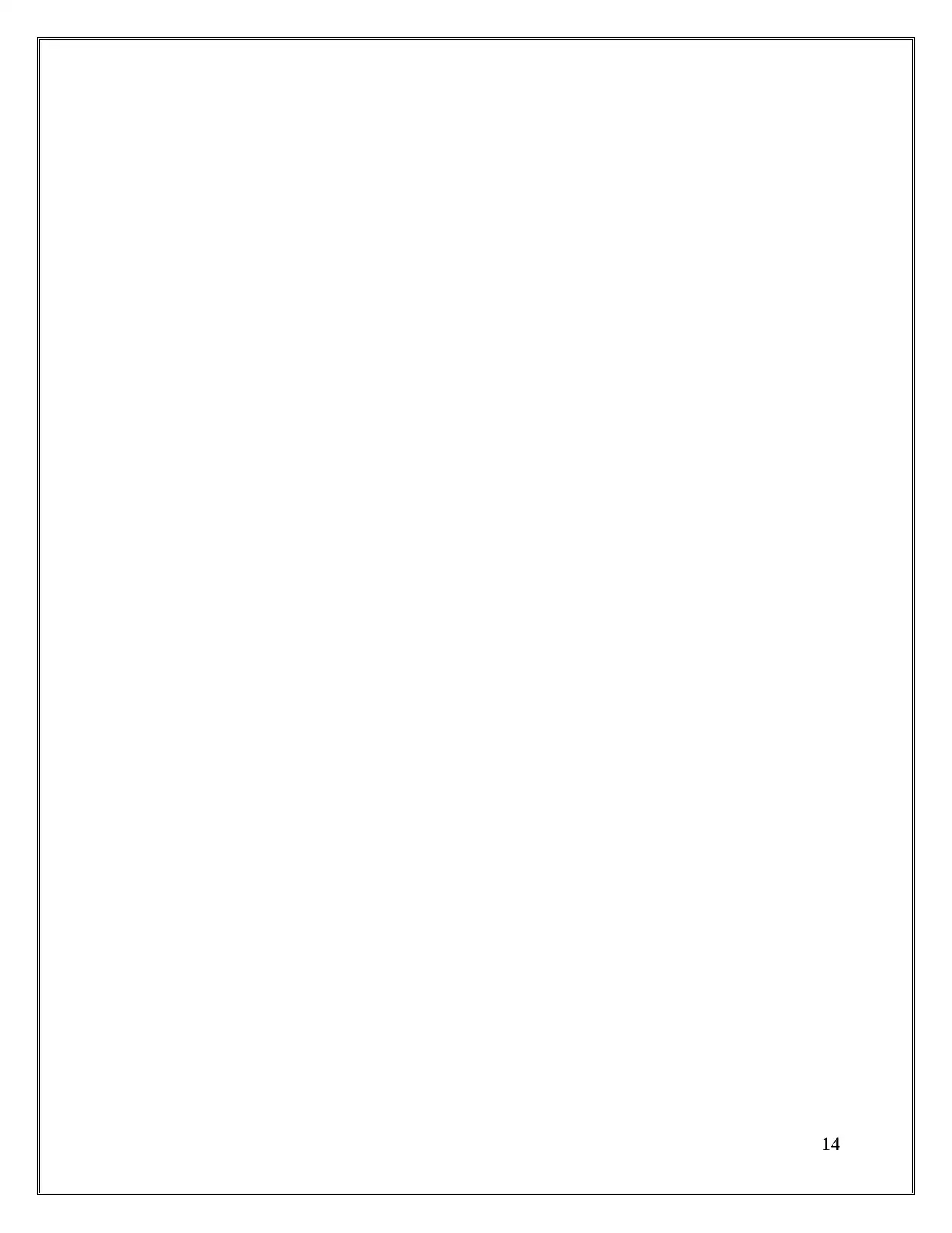
14
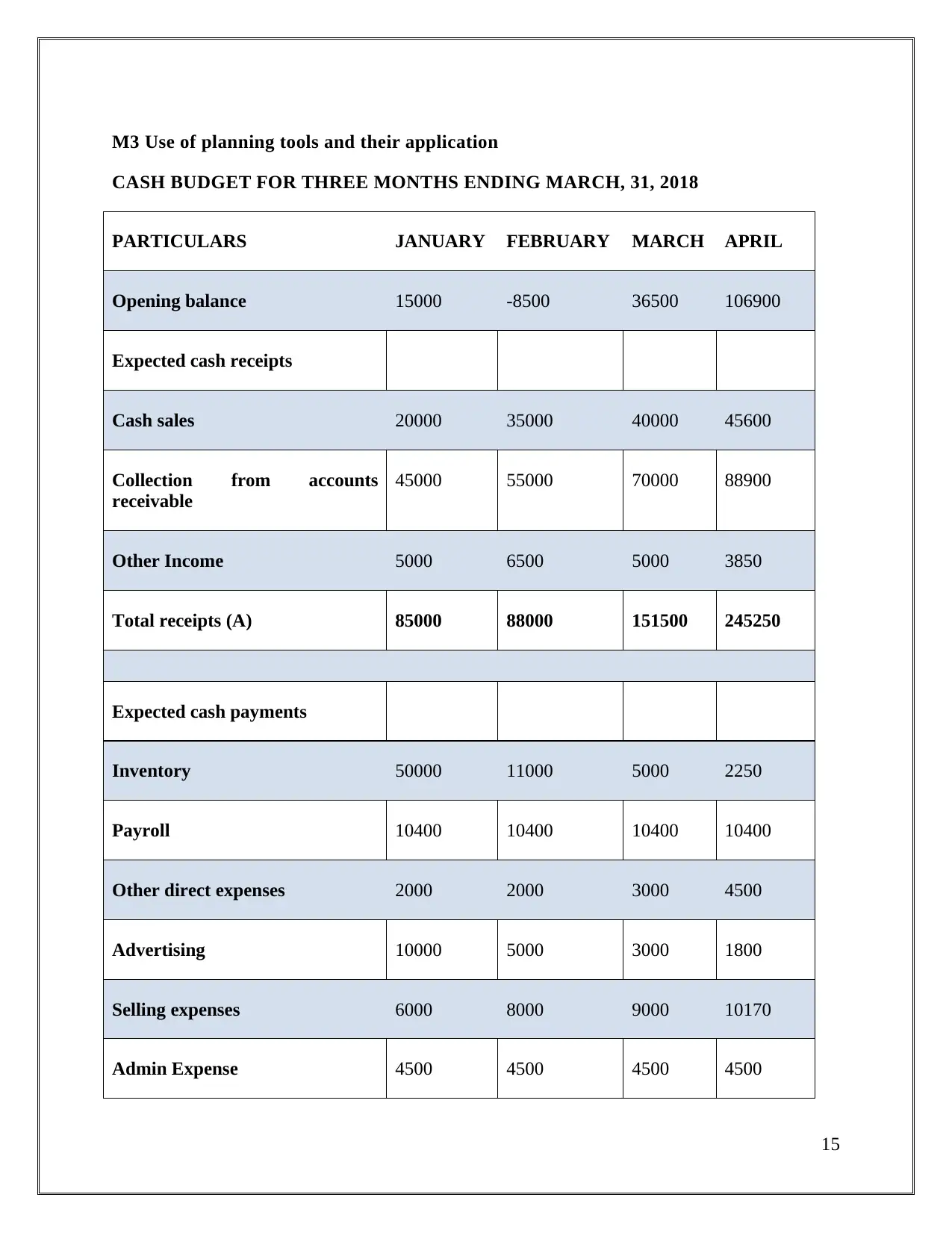
M3 Use of planning tools and their application
CASH BUDGET FOR THREE MONTHS ENDING MARCH, 31, 2018
PARTICULARS JANUARY FEBRUARY MARCH APRIL
Opening balance 15000 -8500 36500 106900
Expected cash receipts
Cash sales 20000 35000 40000 45600
Collection from accounts
receivable
45000 55000 70000 88900
Other Income 5000 6500 5000 3850
Total receipts (A) 85000 88000 151500 245250
Expected cash payments
Inventory 50000 11000 5000 2250
Payroll 10400 10400 10400 10400
Other direct expenses 2000 2000 3000 4500
Advertising 10000 5000 3000 1800
Selling expenses 6000 8000 9000 10170
Admin Expense 4500 4500 4500 4500
15
CASH BUDGET FOR THREE MONTHS ENDING MARCH, 31, 2018
PARTICULARS JANUARY FEBRUARY MARCH APRIL
Opening balance 15000 -8500 36500 106900
Expected cash receipts
Cash sales 20000 35000 40000 45600
Collection from accounts
receivable
45000 55000 70000 88900
Other Income 5000 6500 5000 3850
Total receipts (A) 85000 88000 151500 245250
Expected cash payments
Inventory 50000 11000 5000 2250
Payroll 10400 10400 10400 10400
Other direct expenses 2000 2000 3000 4500
Advertising 10000 5000 3000 1800
Selling expenses 6000 8000 9000 10170
Admin Expense 4500 4500 4500 4500
15
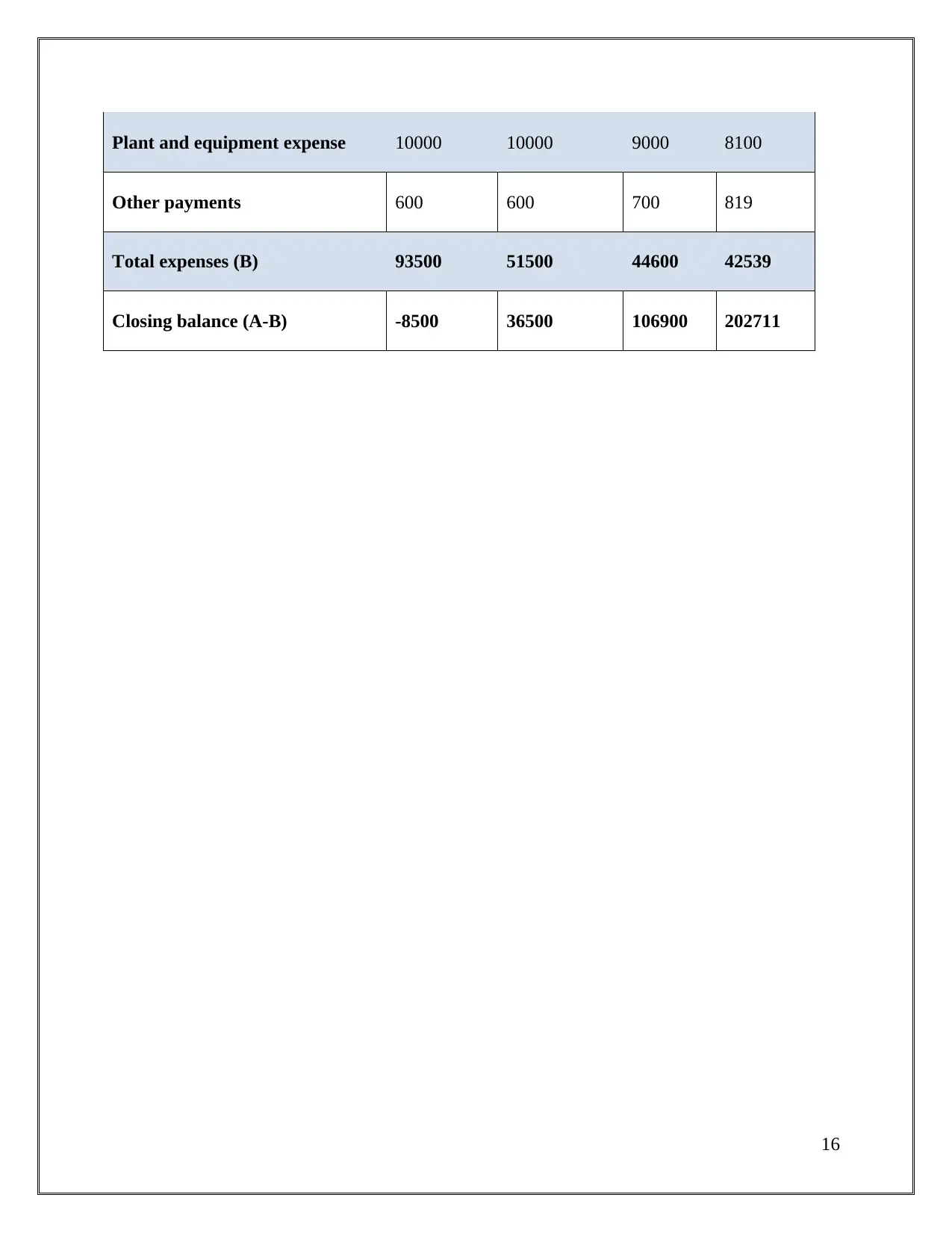
Plant and equipment expense 10000 10000 9000 8100
Other payments 600 600 700 819
Total expenses (B) 93500 51500 44600 42539
Closing balance (A-B) -8500 36500 106900 202711
16
Other payments 600 600 700 819
Total expenses (B) 93500 51500 44600 42539
Closing balance (A-B) -8500 36500 106900 202711
16
Secure Best Marks with AI Grader
Need help grading? Try our AI Grader for instant feedback on your assignments.
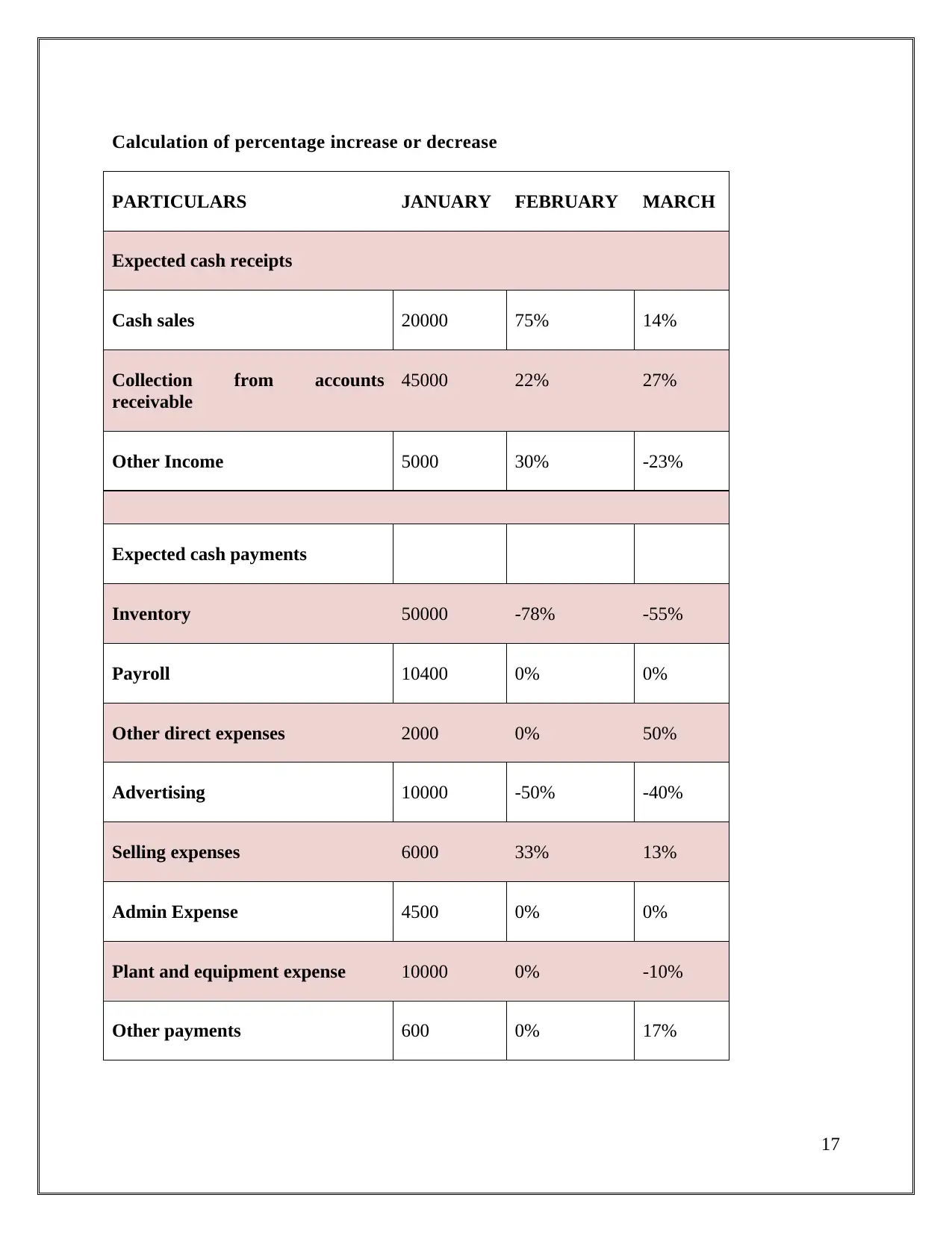
Calculation of percentage increase or decrease
PARTICULARS JANUARY FEBRUARY MARCH
Expected cash receipts
Cash sales 20000 75% 14%
Collection from accounts
receivable
45000 22% 27%
Other Income 5000 30% -23%
Expected cash payments
Inventory 50000 -78% -55%
Payroll 10400 0% 0%
Other direct expenses 2000 0% 50%
Advertising 10000 -50% -40%
Selling expenses 6000 33% 13%
Admin Expense 4500 0% 0%
Plant and equipment expense 10000 0% -10%
Other payments 600 0% 17%
17
PARTICULARS JANUARY FEBRUARY MARCH
Expected cash receipts
Cash sales 20000 75% 14%
Collection from accounts
receivable
45000 22% 27%
Other Income 5000 30% -23%
Expected cash payments
Inventory 50000 -78% -55%
Payroll 10400 0% 0%
Other direct expenses 2000 0% 50%
Advertising 10000 -50% -40%
Selling expenses 6000 33% 13%
Admin Expense 4500 0% 0%
Plant and equipment expense 10000 0% -10%
Other payments 600 0% 17%
17
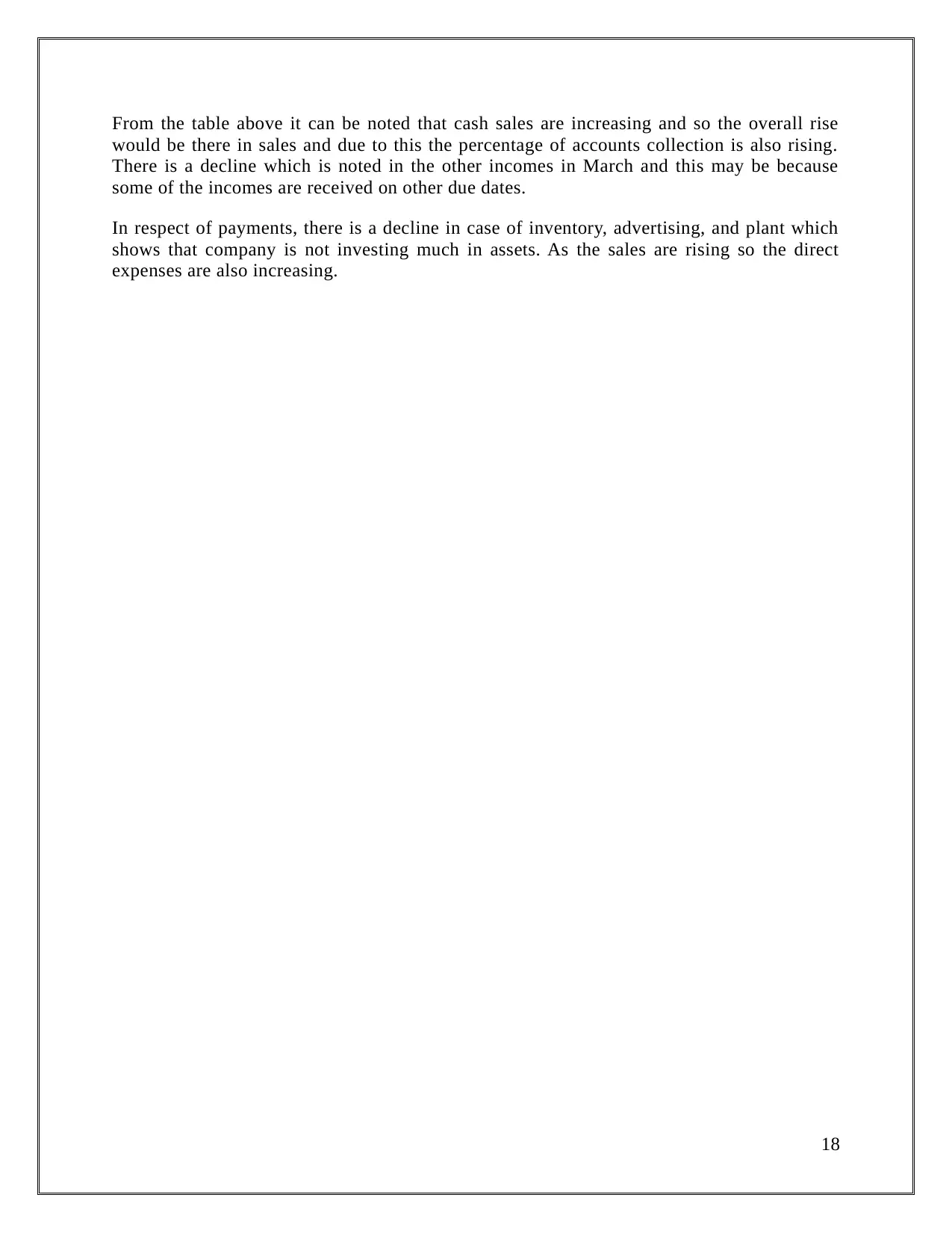
From the table above it can be noted that cash sales are increasing and so the overall rise
would be there in sales and due to this the percentage of accounts collection is also rising.
There is a decline which is noted in the other incomes in March and this may be because
some of the incomes are received on other due dates.
In respect of payments, there is a decline in case of inventory, advertising, and plant which
shows that company is not investing much in assets. As the sales are rising so the direct
expenses are also increasing.
18
would be there in sales and due to this the percentage of accounts collection is also rising.
There is a decline which is noted in the other incomes in March and this may be because
some of the incomes are received on other due dates.
In respect of payments, there is a decline in case of inventory, advertising, and plant which
shows that company is not investing much in assets. As the sales are rising so the direct
expenses are also increasing.
18
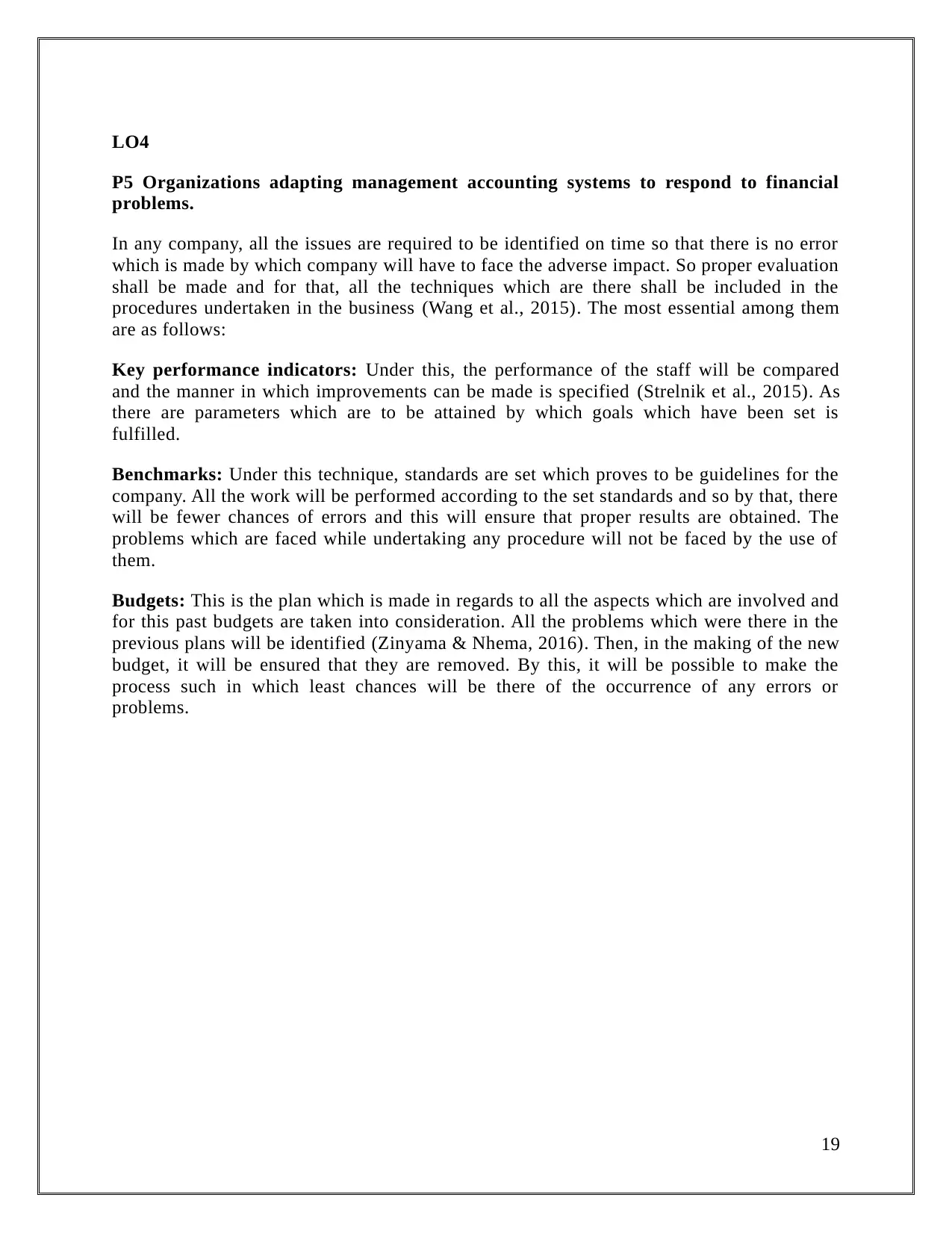
LO4
P5 Organizations adapting management accounting systems to respond to financial
problems.
In any company, all the issues are required to be identified on time so that there is no error
which is made by which company will have to face the adverse impact. So proper evaluation
shall be made and for that, all the techniques which are there shall be included in the
procedures undertaken in the business (Wang et al., 2015). The most essential among them
are as follows:
Key performance indicators: Under this, the performance of the staff will be compared
and the manner in which improvements can be made is specified (Strelnik et al., 2015). As
there are parameters which are to be attained by which goals which have been set is
fulfilled.
Benchmarks: Under this technique, standards are set which proves to be guidelines for the
company. All the work will be performed according to the set standards and so by that, there
will be fewer chances of errors and this will ensure that proper results are obtained. The
problems which are faced while undertaking any procedure will not be faced by the use of
them.
Budgets: This is the plan which is made in regards to all the aspects which are involved and
for this past budgets are taken into consideration. All the problems which were there in the
previous plans will be identified (Zinyama & Nhema, 2016). Then, in the making of the new
budget, it will be ensured that they are removed. By this, it will be possible to make the
process such in which least chances will be there of the occurrence of any errors or
problems.
19
P5 Organizations adapting management accounting systems to respond to financial
problems.
In any company, all the issues are required to be identified on time so that there is no error
which is made by which company will have to face the adverse impact. So proper evaluation
shall be made and for that, all the techniques which are there shall be included in the
procedures undertaken in the business (Wang et al., 2015). The most essential among them
are as follows:
Key performance indicators: Under this, the performance of the staff will be compared
and the manner in which improvements can be made is specified (Strelnik et al., 2015). As
there are parameters which are to be attained by which goals which have been set is
fulfilled.
Benchmarks: Under this technique, standards are set which proves to be guidelines for the
company. All the work will be performed according to the set standards and so by that, there
will be fewer chances of errors and this will ensure that proper results are obtained. The
problems which are faced while undertaking any procedure will not be faced by the use of
them.
Budgets: This is the plan which is made in regards to all the aspects which are involved and
for this past budgets are taken into consideration. All the problems which were there in the
previous plans will be identified (Zinyama & Nhema, 2016). Then, in the making of the new
budget, it will be ensured that they are removed. By this, it will be possible to make the
process such in which least chances will be there of the occurrence of any errors or
problems.
19
Paraphrase This Document
Need a fresh take? Get an instant paraphrase of this document with our AI Paraphraser
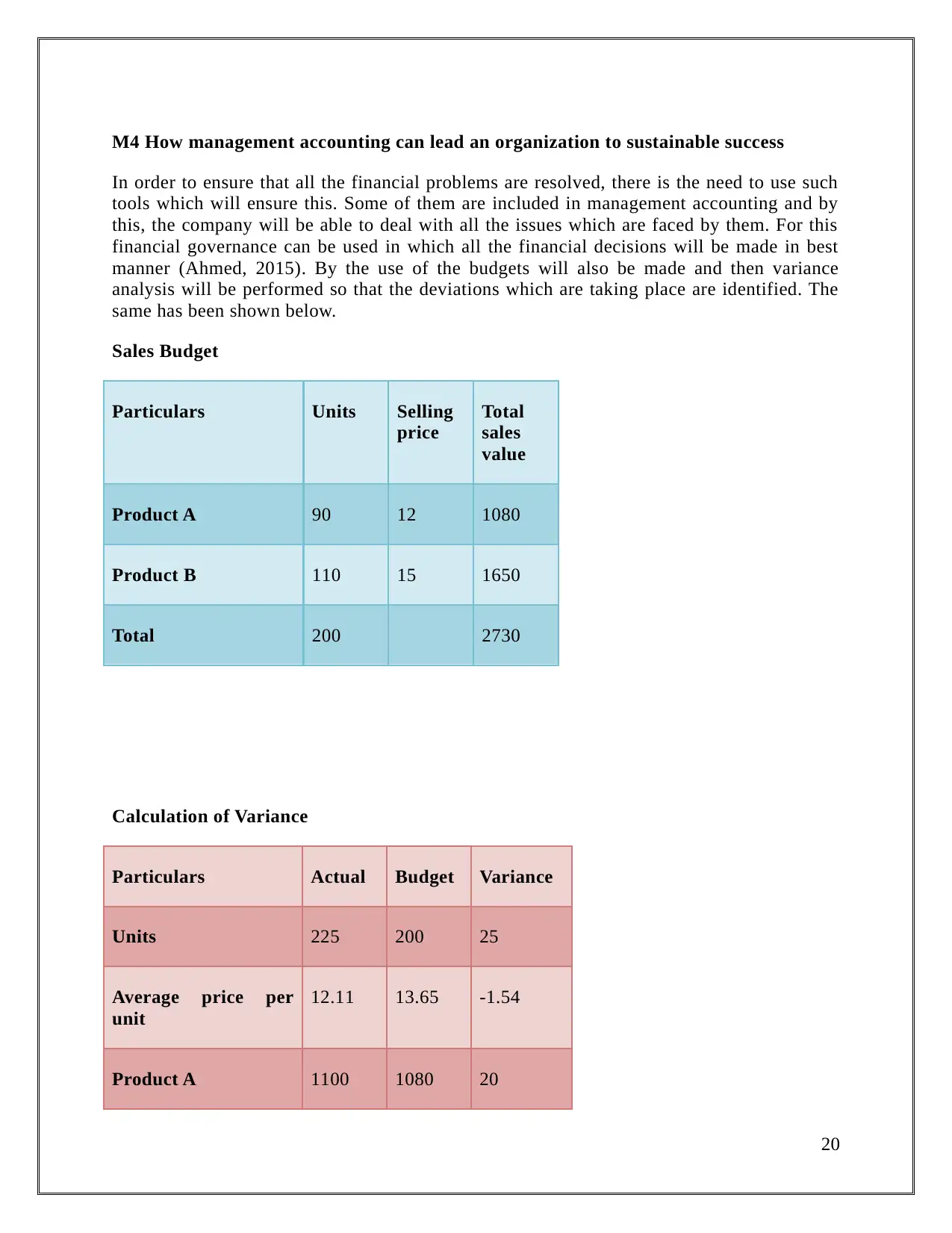
M4 How management accounting can lead an organization to sustainable success
In order to ensure that all the financial problems are resolved, there is the need to use such
tools which will ensure this. Some of them are included in management accounting and by
this, the company will be able to deal with all the issues which are faced by them. For this
financial governance can be used in which all the financial decisions will be made in best
manner (Ahmed, 2015). By the use of the budgets will also be made and then variance
analysis will be performed so that the deviations which are taking place are identified. The
same has been shown below.
Sales Budget
Particulars Units Selling
price
Total
sales
value
Product A 90 12 1080
Product B 110 15 1650
Total 200 2730
Calculation of Variance
Particulars Actual Budget Variance
Units 225 200 25
Average price per
unit
12.11 13.65 -1.54
Product A 1100 1080 20
20
In order to ensure that all the financial problems are resolved, there is the need to use such
tools which will ensure this. Some of them are included in management accounting and by
this, the company will be able to deal with all the issues which are faced by them. For this
financial governance can be used in which all the financial decisions will be made in best
manner (Ahmed, 2015). By the use of the budgets will also be made and then variance
analysis will be performed so that the deviations which are taking place are identified. The
same has been shown below.
Sales Budget
Particulars Units Selling
price
Total
sales
value
Product A 90 12 1080
Product B 110 15 1650
Total 200 2730
Calculation of Variance
Particulars Actual Budget Variance
Units 225 200 25
Average price per
unit
12.11 13.65 -1.54
Product A 1100 1080 20
20
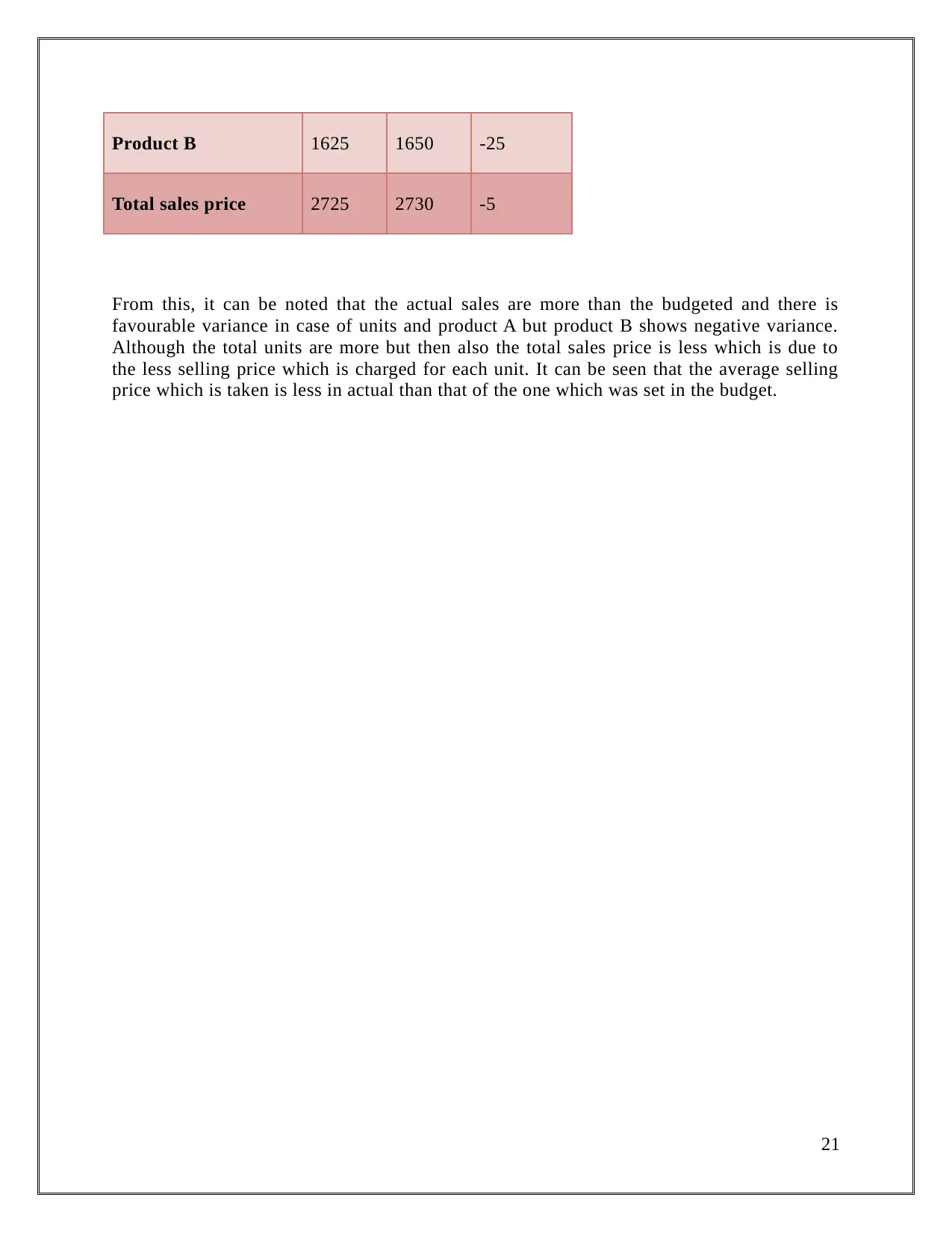
Product B 1625 1650 -25
Total sales price 2725 2730 -5
From this, it can be noted that the actual sales are more than the budgeted and there is
favourable variance in case of units and product A but product B shows negative variance.
Although the total units are more but then also the total sales price is less which is due to
the less selling price which is charged for each unit. It can be seen that the average selling
price which is taken is less in actual than that of the one which was set in the budget.
21
Total sales price 2725 2730 -5
From this, it can be noted that the actual sales are more than the budgeted and there is
favourable variance in case of units and product A but product B shows negative variance.
Although the total units are more but then also the total sales price is less which is due to
the less selling price which is charged for each unit. It can be seen that the average selling
price which is taken is less in actual than that of the one which was set in the budget.
21
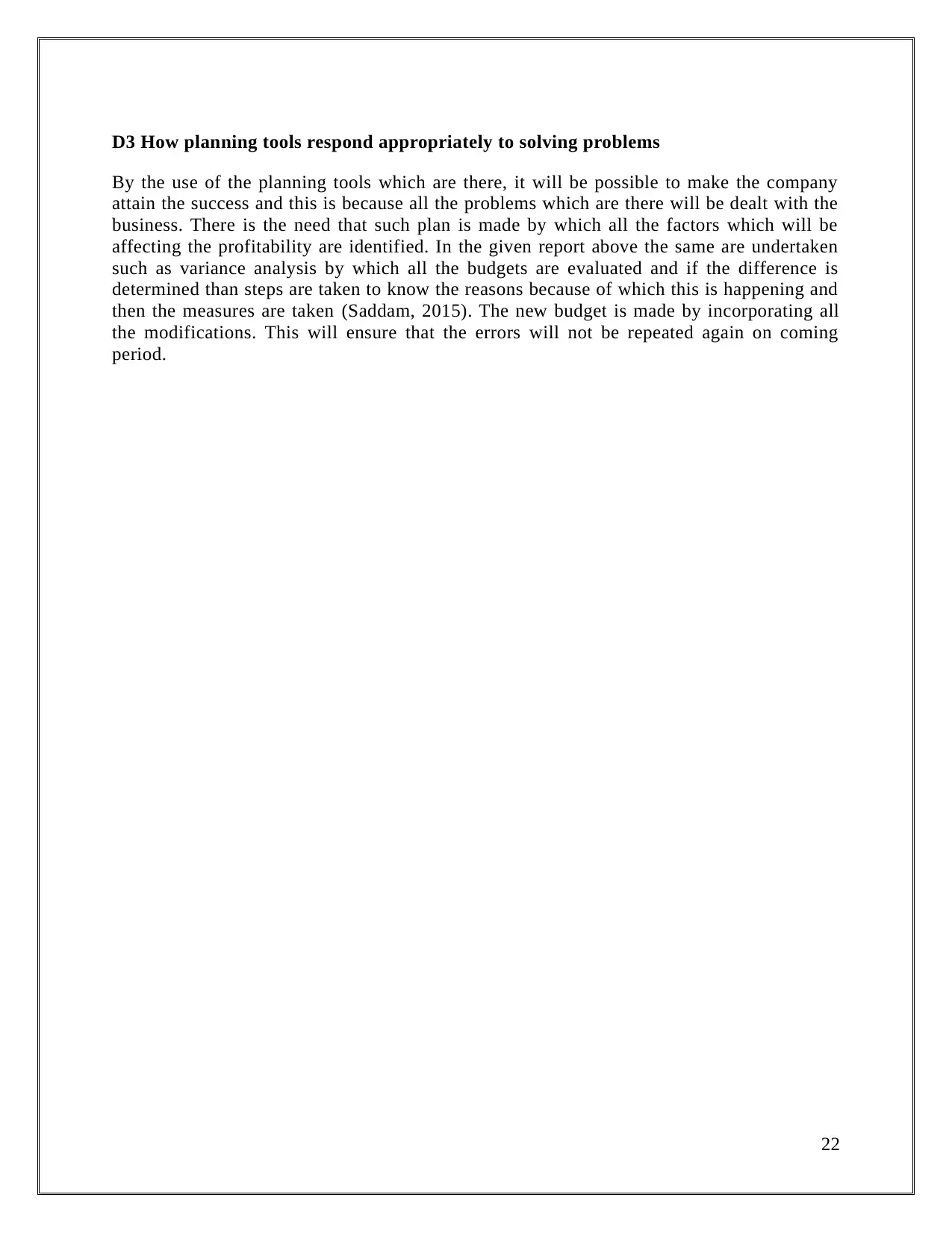
D3 How planning tools respond appropriately to solving problems
By the use of the planning tools which are there, it will be possible to make the company
attain the success and this is because all the problems which are there will be dealt with the
business. There is the need that such plan is made by which all the factors which will be
affecting the profitability are identified. In the given report above the same are undertaken
such as variance analysis by which all the budgets are evaluated and if the difference is
determined than steps are taken to know the reasons because of which this is happening and
then the measures are taken (Saddam, 2015). The new budget is made by incorporating all
the modifications. This will ensure that the errors will not be repeated again on coming
period.
22
By the use of the planning tools which are there, it will be possible to make the company
attain the success and this is because all the problems which are there will be dealt with the
business. There is the need that such plan is made by which all the factors which will be
affecting the profitability are identified. In the given report above the same are undertaken
such as variance analysis by which all the budgets are evaluated and if the difference is
determined than steps are taken to know the reasons because of which this is happening and
then the measures are taken (Saddam, 2015). The new budget is made by incorporating all
the modifications. This will ensure that the errors will not be repeated again on coming
period.
22
Secure Best Marks with AI Grader
Need help grading? Try our AI Grader for instant feedback on your assignments.
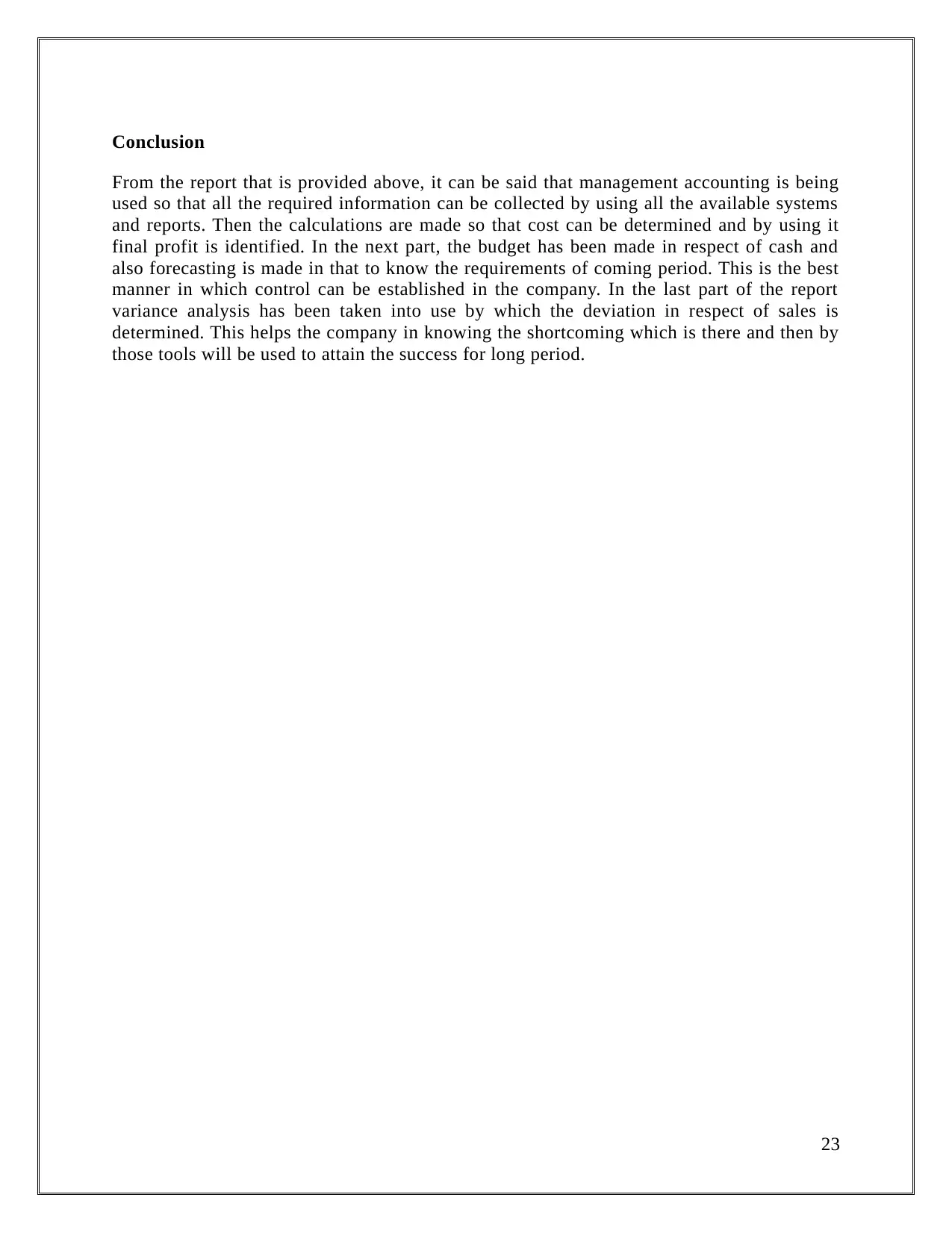
Conclusion
From the report that is provided above, it can be said that management accounting is being
used so that all the required information can be collected by using all the available systems
and reports. Then the calculations are made so that cost can be determined and by using it
final profit is identified. In the next part, the budget has been made in respect of cash and
also forecasting is made in that to know the requirements of coming period. This is the best
manner in which control can be established in the company. In the last part of the report
variance analysis has been taken into use by which the deviation in respect of sales is
determined. This helps the company in knowing the shortcoming which is there and then by
those tools will be used to attain the success for long period.
23
From the report that is provided above, it can be said that management accounting is being
used so that all the required information can be collected by using all the available systems
and reports. Then the calculations are made so that cost can be determined and by using it
final profit is identified. In the next part, the budget has been made in respect of cash and
also forecasting is made in that to know the requirements of coming period. This is the best
manner in which control can be established in the company. In the last part of the report
variance analysis has been taken into use by which the deviation in respect of sales is
determined. This helps the company in knowing the shortcoming which is there and then by
those tools will be used to attain the success for long period.
23
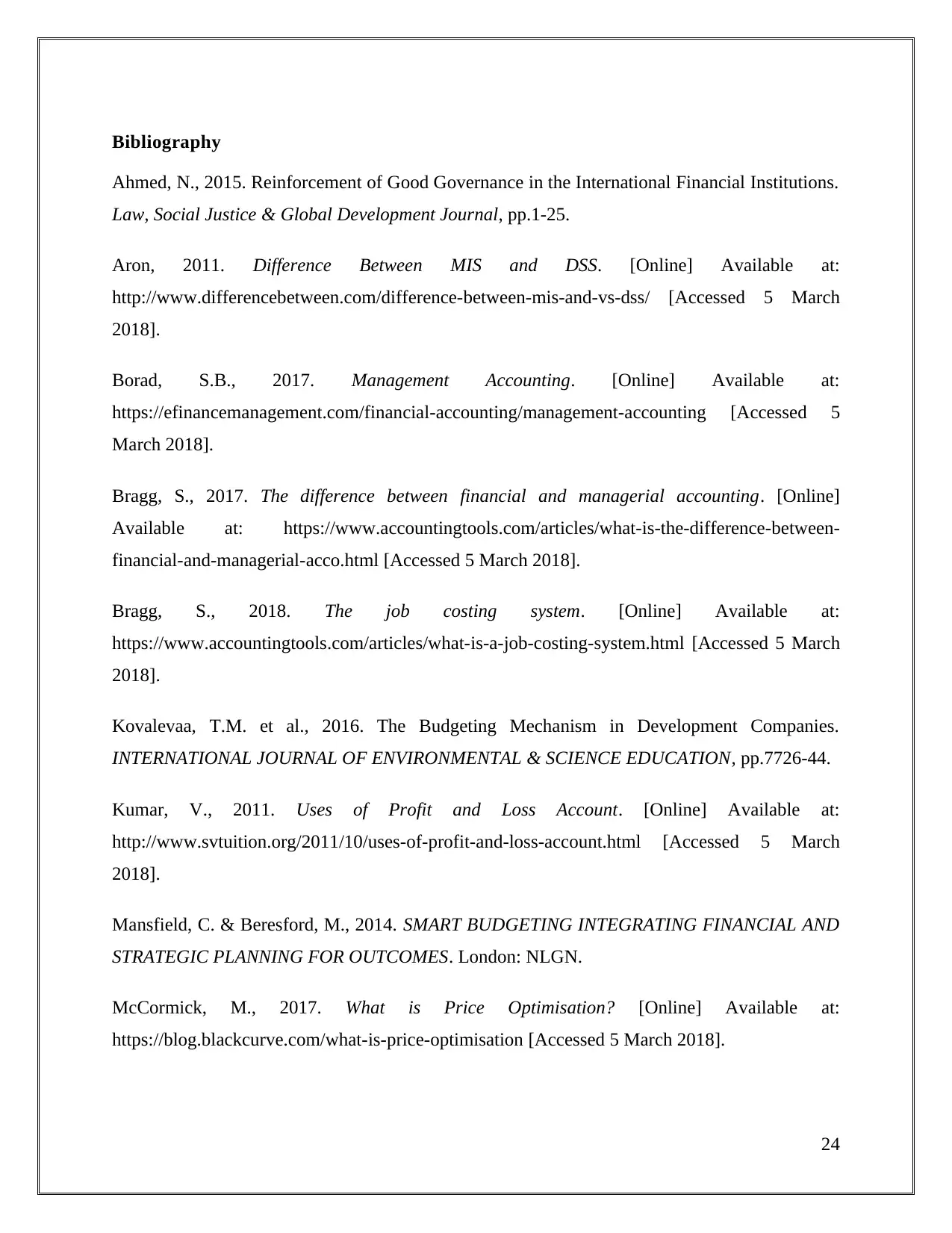
Bibliography
Ahmed, N., 2015. Reinforcement of Good Governance in the International Financial Institutions.
Law, Social Justice & Global Development Journal, pp.1-25.
Aron, 2011. Difference Between MIS and DSS. [Online] Available at:
http://www.differencebetween.com/difference-between-mis-and-vs-dss/ [Accessed 5 March
2018].
Borad, S.B., 2017. Management Accounting. [Online] Available at:
https://efinancemanagement.com/financial-accounting/management-accounting [Accessed 5
March 2018].
Bragg, S., 2017. The difference between financial and managerial accounting. [Online]
Available at: https://www.accountingtools.com/articles/what-is-the-difference-between-
financial-and-managerial-acco.html [Accessed 5 March 2018].
Bragg, S., 2018. The job costing system. [Online] Available at:
https://www.accountingtools.com/articles/what-is-a-job-costing-system.html [Accessed 5 March
2018].
Kovalevaa, T.M. et al., 2016. The Budgeting Mechanism in Development Companies.
INTERNATIONAL JOURNAL OF ENVIRONMENTAL & SCIENCE EDUCATION, pp.7726-44.
Kumar, V., 2011. Uses of Profit and Loss Account. [Online] Available at:
http://www.svtuition.org/2011/10/uses-of-profit-and-loss-account.html [Accessed 5 March
2018].
Mansfield, C. & Beresford, M., 2014. SMART BUDGETING INTEGRATING FINANCIAL AND
STRATEGIC PLANNING FOR OUTCOMES. London: NLGN.
McCormick, M., 2017. What is Price Optimisation? [Online] Available at:
https://blog.blackcurve.com/what-is-price-optimisation [Accessed 5 March 2018].
24
Ahmed, N., 2015. Reinforcement of Good Governance in the International Financial Institutions.
Law, Social Justice & Global Development Journal, pp.1-25.
Aron, 2011. Difference Between MIS and DSS. [Online] Available at:
http://www.differencebetween.com/difference-between-mis-and-vs-dss/ [Accessed 5 March
2018].
Borad, S.B., 2017. Management Accounting. [Online] Available at:
https://efinancemanagement.com/financial-accounting/management-accounting [Accessed 5
March 2018].
Bragg, S., 2017. The difference between financial and managerial accounting. [Online]
Available at: https://www.accountingtools.com/articles/what-is-the-difference-between-
financial-and-managerial-acco.html [Accessed 5 March 2018].
Bragg, S., 2018. The job costing system. [Online] Available at:
https://www.accountingtools.com/articles/what-is-a-job-costing-system.html [Accessed 5 March
2018].
Kovalevaa, T.M. et al., 2016. The Budgeting Mechanism in Development Companies.
INTERNATIONAL JOURNAL OF ENVIRONMENTAL & SCIENCE EDUCATION, pp.7726-44.
Kumar, V., 2011. Uses of Profit and Loss Account. [Online] Available at:
http://www.svtuition.org/2011/10/uses-of-profit-and-loss-account.html [Accessed 5 March
2018].
Mansfield, C. & Beresford, M., 2014. SMART BUDGETING INTEGRATING FINANCIAL AND
STRATEGIC PLANNING FOR OUTCOMES. London: NLGN.
McCormick, M., 2017. What is Price Optimisation? [Online] Available at:
https://blog.blackcurve.com/what-is-price-optimisation [Accessed 5 March 2018].
24
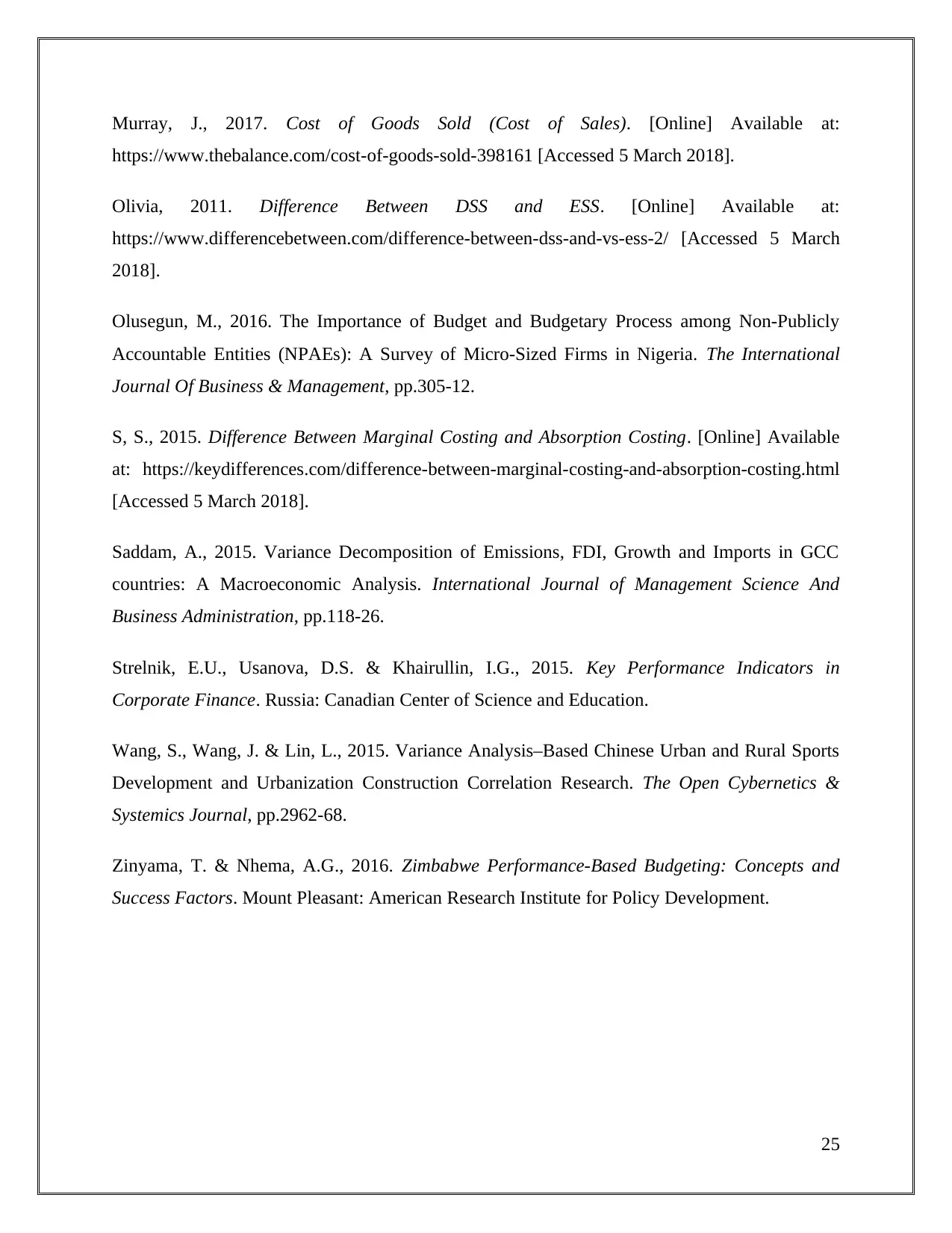
Murray, J., 2017. Cost of Goods Sold (Cost of Sales). [Online] Available at:
https://www.thebalance.com/cost-of-goods-sold-398161 [Accessed 5 March 2018].
Olivia, 2011. Difference Between DSS and ESS. [Online] Available at:
https://www.differencebetween.com/difference-between-dss-and-vs-ess-2/ [Accessed 5 March
2018].
Olusegun, M., 2016. The Importance of Budget and Budgetary Process among Non-Publicly
Accountable Entities (NPAEs): A Survey of Micro-Sized Firms in Nigeria. The International
Journal Of Business & Management, pp.305-12.
S, S., 2015. Difference Between Marginal Costing and Absorption Costing. [Online] Available
at: https://keydifferences.com/difference-between-marginal-costing-and-absorption-costing.html
[Accessed 5 March 2018].
Saddam, A., 2015. Variance Decomposition of Emissions, FDI, Growth and Imports in GCC
countries: A Macroeconomic Analysis. International Journal of Management Science And
Business Administration, pp.118-26.
Strelnik, E.U., Usanova, D.S. & Khairullin, I.G., 2015. Key Performance Indicators in
Corporate Finance. Russia: Canadian Center of Science and Education.
Wang, S., Wang, J. & Lin, L., 2015. Variance Analysis–Based Chinese Urban and Rural Sports
Development and Urbanization Construction Correlation Research. The Open Cybernetics &
Systemics Journal, pp.2962-68.
Zinyama, T. & Nhema, A.G., 2016. Zimbabwe Performance-Based Budgeting: Concepts and
Success Factors. Mount Pleasant: American Research Institute for Policy Development.
25
https://www.thebalance.com/cost-of-goods-sold-398161 [Accessed 5 March 2018].
Olivia, 2011. Difference Between DSS and ESS. [Online] Available at:
https://www.differencebetween.com/difference-between-dss-and-vs-ess-2/ [Accessed 5 March
2018].
Olusegun, M., 2016. The Importance of Budget and Budgetary Process among Non-Publicly
Accountable Entities (NPAEs): A Survey of Micro-Sized Firms in Nigeria. The International
Journal Of Business & Management, pp.305-12.
S, S., 2015. Difference Between Marginal Costing and Absorption Costing. [Online] Available
at: https://keydifferences.com/difference-between-marginal-costing-and-absorption-costing.html
[Accessed 5 March 2018].
Saddam, A., 2015. Variance Decomposition of Emissions, FDI, Growth and Imports in GCC
countries: A Macroeconomic Analysis. International Journal of Management Science And
Business Administration, pp.118-26.
Strelnik, E.U., Usanova, D.S. & Khairullin, I.G., 2015. Key Performance Indicators in
Corporate Finance. Russia: Canadian Center of Science and Education.
Wang, S., Wang, J. & Lin, L., 2015. Variance Analysis–Based Chinese Urban and Rural Sports
Development and Urbanization Construction Correlation Research. The Open Cybernetics &
Systemics Journal, pp.2962-68.
Zinyama, T. & Nhema, A.G., 2016. Zimbabwe Performance-Based Budgeting: Concepts and
Success Factors. Mount Pleasant: American Research Institute for Policy Development.
25
Paraphrase This Document
Need a fresh take? Get an instant paraphrase of this document with our AI Paraphraser
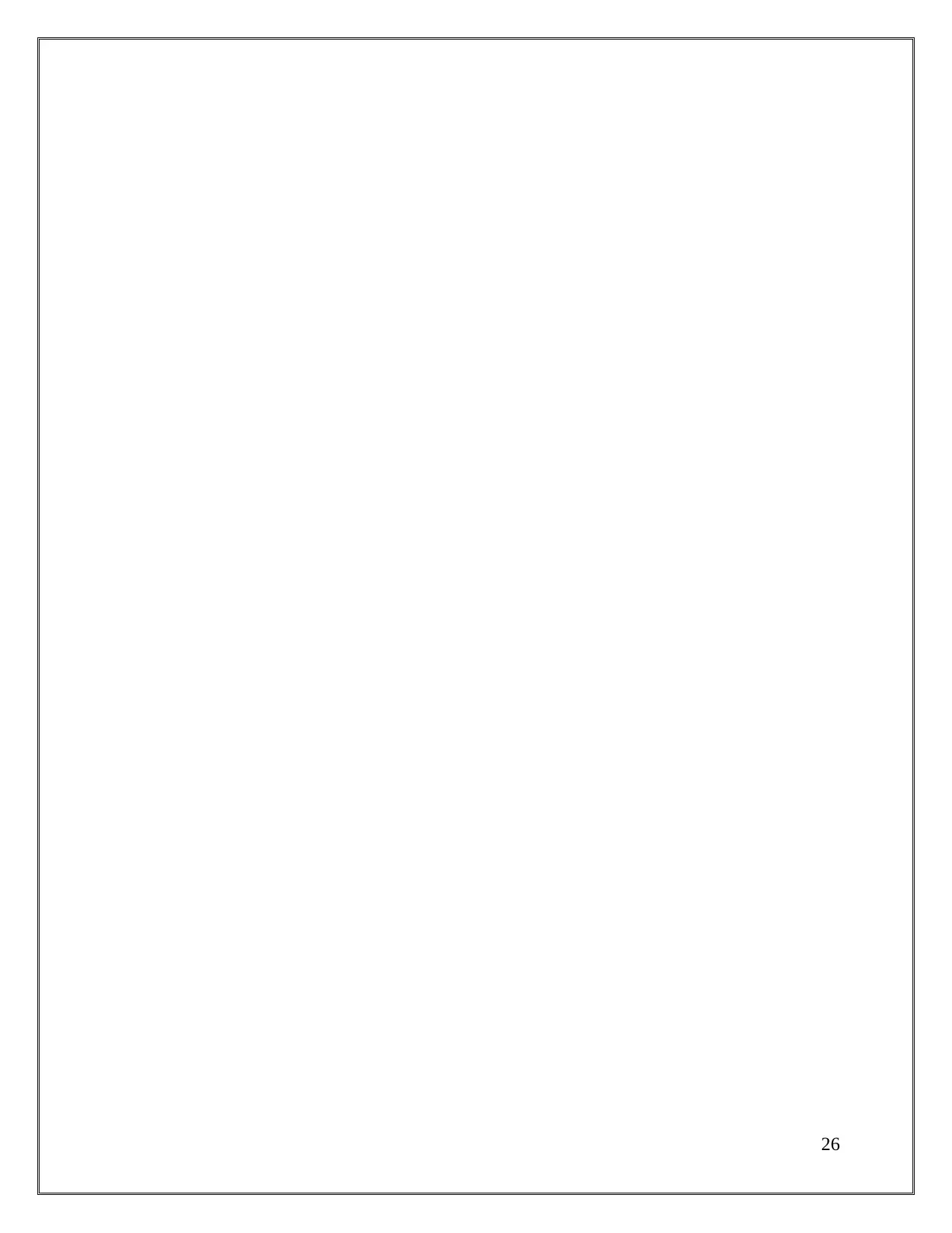
26
1 out of 26
Related Documents
Your All-in-One AI-Powered Toolkit for Academic Success.
+13062052269
info@desklib.com
Available 24*7 on WhatsApp / Email
![[object Object]](/_next/static/media/star-bottom.7253800d.svg)
Unlock your academic potential
© 2024 | Zucol Services PVT LTD | All rights reserved.





